
Update from the SETI Institute NAI Team 2018 Expedition to the Andes
Nathalie Cabrol, Director of the Carl Sagan Center for the Study of Life in the Universe, is leading the SETI Institute NAI team on its 2018 field expedition to the Andes:
“This year, between October 17-November 20, 2018, my team and I are returning to the Chilean High Andes,” said Nathalie. “There we will continue the development of new planetary exploration strategies, instruments, and systems, that in the near future will dramatically change the way we search for life beyond Earth. Our project is supported by the NASA Astrobiology Institute and helps prepare missions such as Mars 2020 and ExoMars that will soon seek traces of ancient biosignatures on the Red Planet.”
While the team is in Chile, Nathalie will be providing updates when she is able to be in an area with an Internet connection. The photos are amazing!
Follow along with us:
FIELD UPDATE 1
Pajonales: Biosignature Detection in Mars Analog Environment
Our team arrived safely in Chile and spent several days (Nov. 1-3) at our first site, Salar de Pajonales, deploying instruments and performing experiments. Some of the instruments we brought with us are equivalent to those that will be onboard NASA’s Mars 2020 and ESA’s ExoMars.
Our goal is to support these missions by understanding how we transition from the characterization of planetary habitability – the type of exploration that was performed in the past 15 years, to searching for ancient or recent biosignatures on Mars, that is the goal of the upcoming missions.
Habitability is primarily defined by astronomy and environment (physicochemical conditions), whereas ancient habitats are defined by biology, in this case, microbial life. Their scales (habitability vs. habitats) and the resolution needed to explore them are vastly different, which means that exploration strategies and methods must adapt. One of the main questions is then how much the data we have at global to regional scales inform us about the patterns that we should be searching for when exploring for microbial habitats, and how we can integrate this information from orbit to the ground?
This is what we are documenting in Chile in the coming 3 weeks with a number of cameras, including a visible camera, Raman and XRD-XRF spectrometers, drones, drills, experiments that include organics, DNA, all sorts of microenvironmental sensing and sampling, and much more. Salar de Pajonales is for most a dry lakebed with a vast field of gypsum mounds and polygons that offer very localized and small scale, repeatable habitats to extremophiles. Located at the boundary of the Atacama desert, it provides a great analog to ancient Martian lakes (see photos).
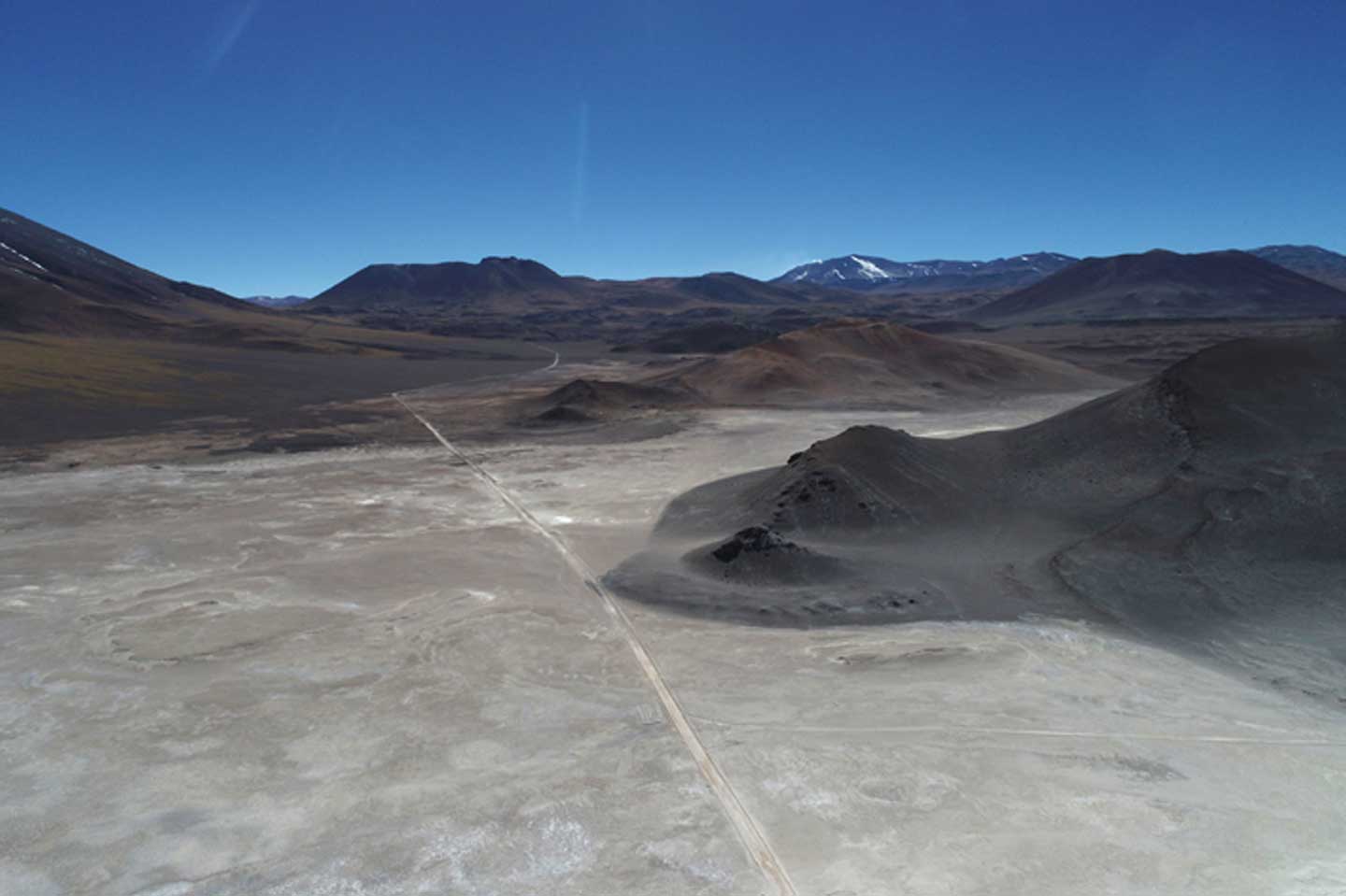 Salar de Pajonales (photo 80) (3,600 m/ 11,800 ft)| Otherworldly landscape at the boundary between the Atacama desert and the Altiplano. In the horizon, the Lastaria volcano continues to spew large plumes of water vapor and sulfur. Credit image: Michael Phillips, University of Tennessee Knoxville and the SETI Institute NAI Team.
Salar de Pajonales (photo 80) (3,600 m/ 11,800 ft)| Otherworldly landscape at the boundary between the Atacama desert and the Altiplano. In the horizon, the Lastaria volcano continues to spew large plumes of water vapor and sulfur. Credit image: Michael Phillips, University of Tennessee Knoxville and the SETI Institute NAI Team.
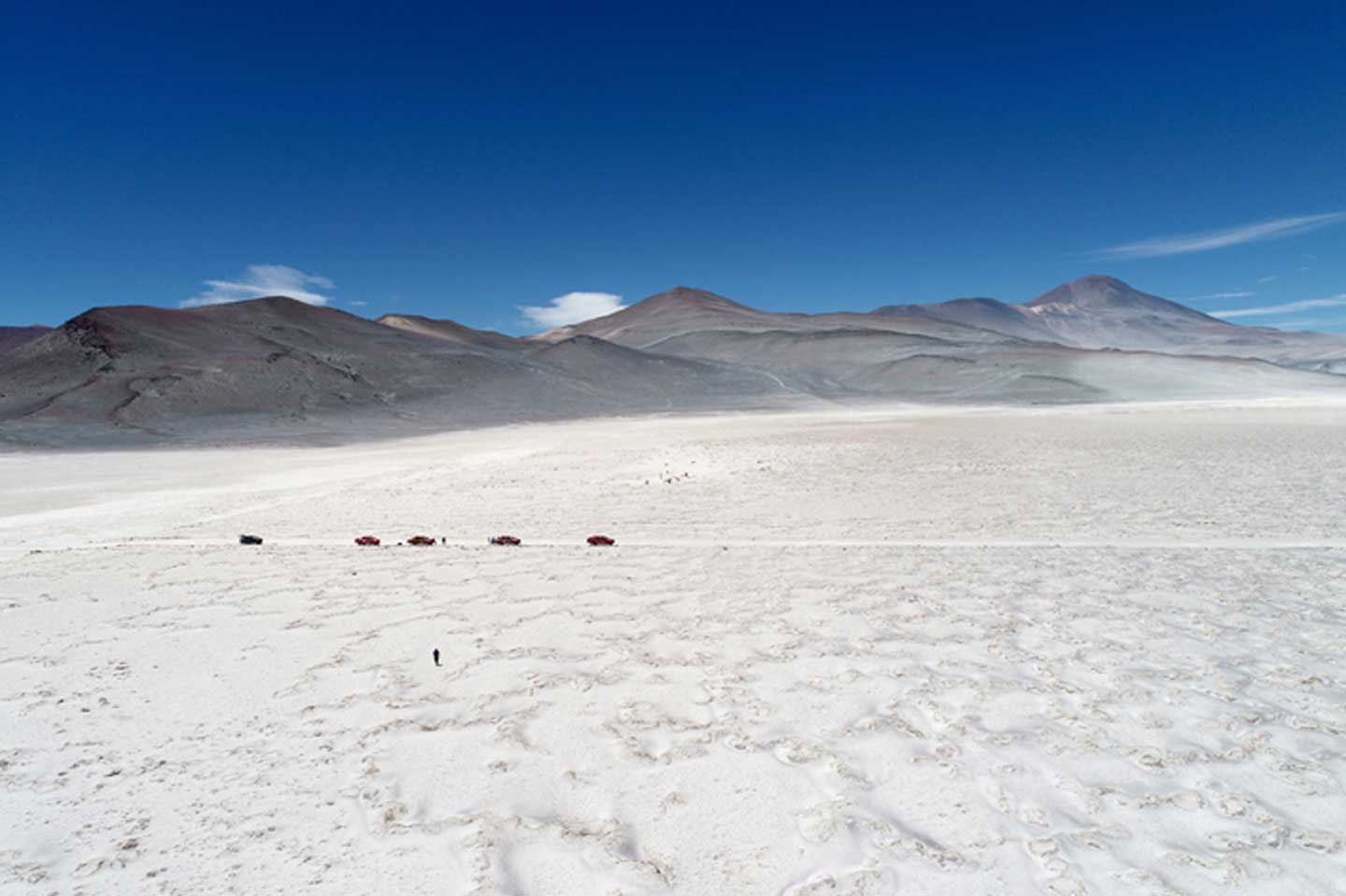 Human scale of Exploration (photo 81) | Drone imagery provides the bird eye’s view of our team at work in Salar de Pajonales. It also reveals critical clues about the landscapes and the patterns associated with microbial habitats that are not always easily visible from the ground. For instance, while small fields of polygons are obvious when we walk in the salar, the larger polygon patterns become obvious only from the air. Credit image: Michael Phillips, University of Tennessee Knoxville and the SETI Institute NAI Team.
Human scale of Exploration (photo 81) | Drone imagery provides the bird eye’s view of our team at work in Salar de Pajonales. It also reveals critical clues about the landscapes and the patterns associated with microbial habitats that are not always easily visible from the ground. For instance, while small fields of polygons are obvious when we walk in the salar, the larger polygon patterns become obvious only from the air. Credit image: Michael Phillips, University of Tennessee Knoxville and the SETI Institute NAI Team.
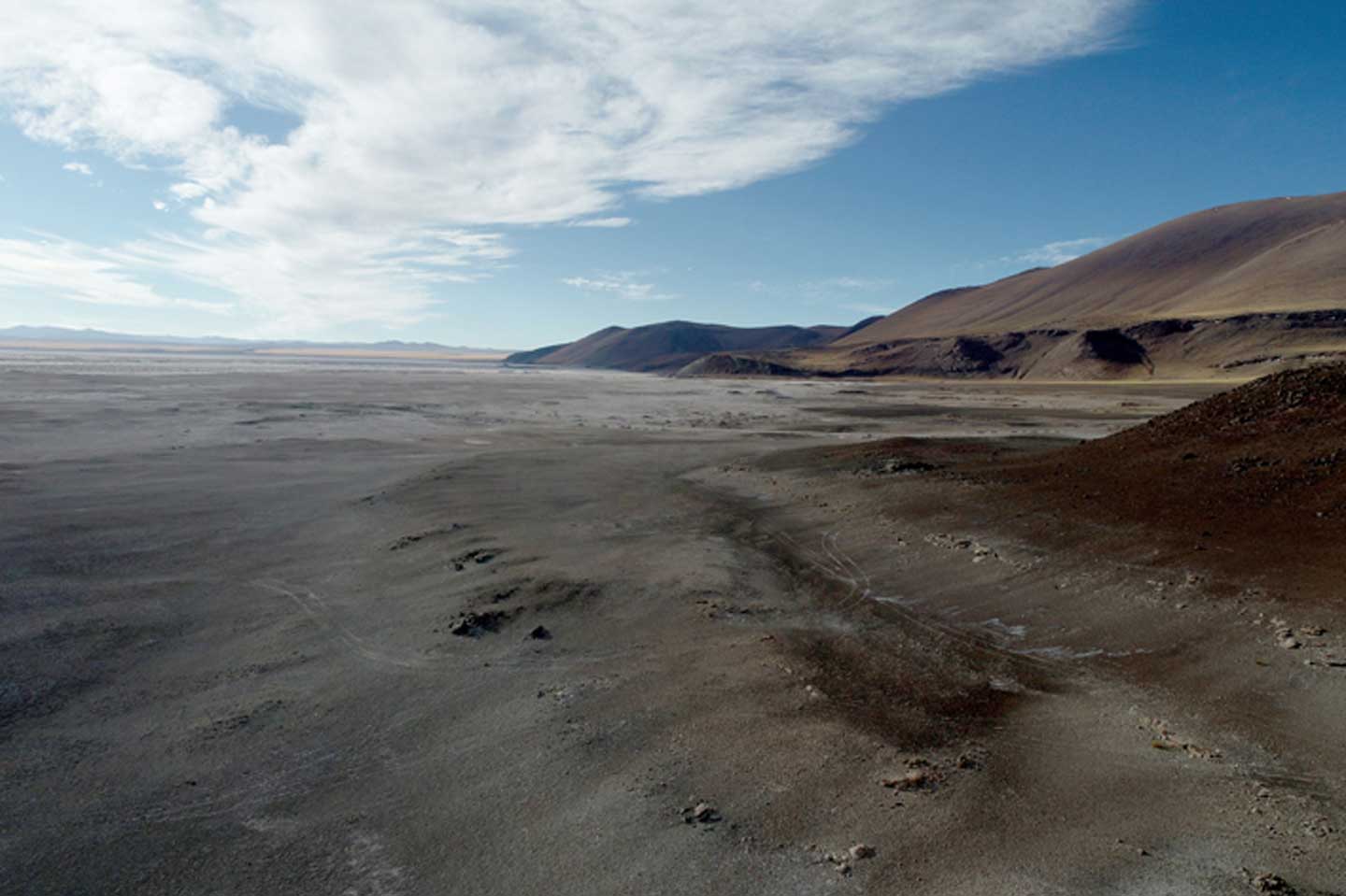 Windstorm (photo 82) | Nov 2, a windstorm started in early morning and stopped as abruptly as it had started around 5PM. The wind was fierce and created an amazing game of shadows and light all day long. In this barren desert, life is nowhere to be seen at the surface. It is hiding in very localized subsurface habitats. Credit image: Michael Phillips, University of Tennessee Knoxville and the SETI Institute NAI Team.
Windstorm (photo 82) | Nov 2, a windstorm started in early morning and stopped as abruptly as it had started around 5PM. The wind was fierce and created an amazing game of shadows and light all day long. In this barren desert, life is nowhere to be seen at the surface. It is hiding in very localized subsurface habitats. Credit image: Michael Phillips, University of Tennessee Knoxville and the SETI Institute NAI Team.
The Expedition by the Numbers
- 19 scientists
- 13 institutions and companies
- 4 countries (Chile, USA, Spain, Mexico)
- 2 medical doctors
- 2 cooks
- A 5 member team for logistical support
- 2 National Geographic photographers
- 7 pickup trucks; 1 truck for the equipment
- 4.5 tons of equipment
- 5 exploration sites
And the odometer is still running. We are barely coming back from site one and the odometer for our convoy is already close to 1,000 km, most of them in conditions that would not really qualify as dirt trails. We call it the altiplanic “massage”.
Participating Institutions and Companies
- The SETI Institute
- Campoalto
- Carnegie Mellon University, The Robotics Institute
- Centro de Astrobiología de Madrid, Spain
- Honeybee Robotics
- National Geographic
- Pacific Northwest National Laboratory
- Panorama Research Institute
- Universidad Catolica del Norte, Antofagasta, Chile
- University of Guam
- University of Montana
- University of Southern California
- University of Tennessee, Knoxville
FIELD UPDATE 2
November 7, 2018
Landscapes of El Tatio...The geyser field is located at 4,300 m elevation (a 14,110 ft) and is the third one in the world. Amazing scenery. The team is working so hard. We have long days but the data keep coming. We also have a little visitor from time to time on the side of the road... Sending hugs and love from the altiplano.
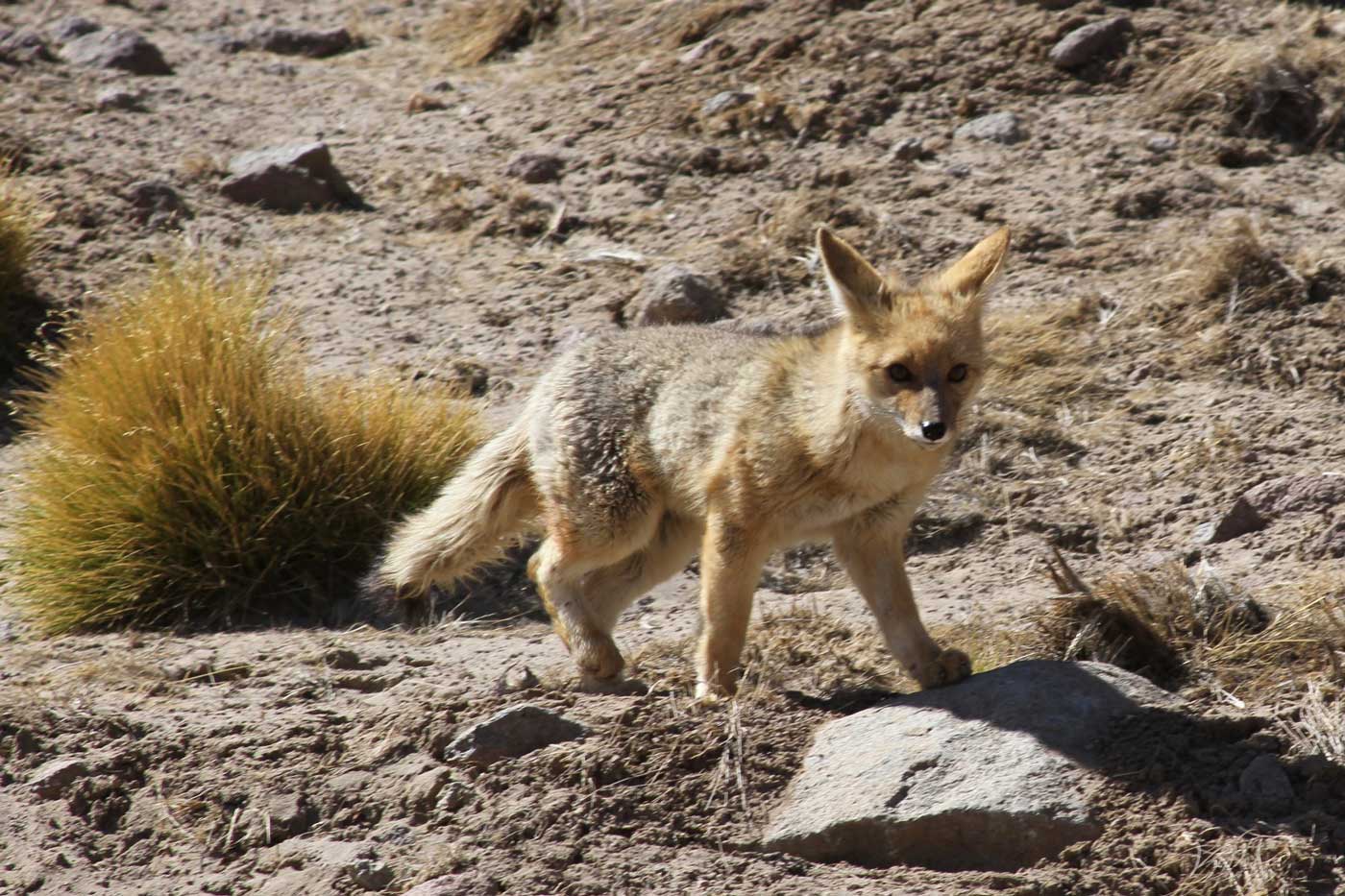
We also have our daily Fox News in the altiplano, but frankly, no contest. I love this one much better! Credit photo: David Wettergreen, CMU/ The SETI Institute NAI team.
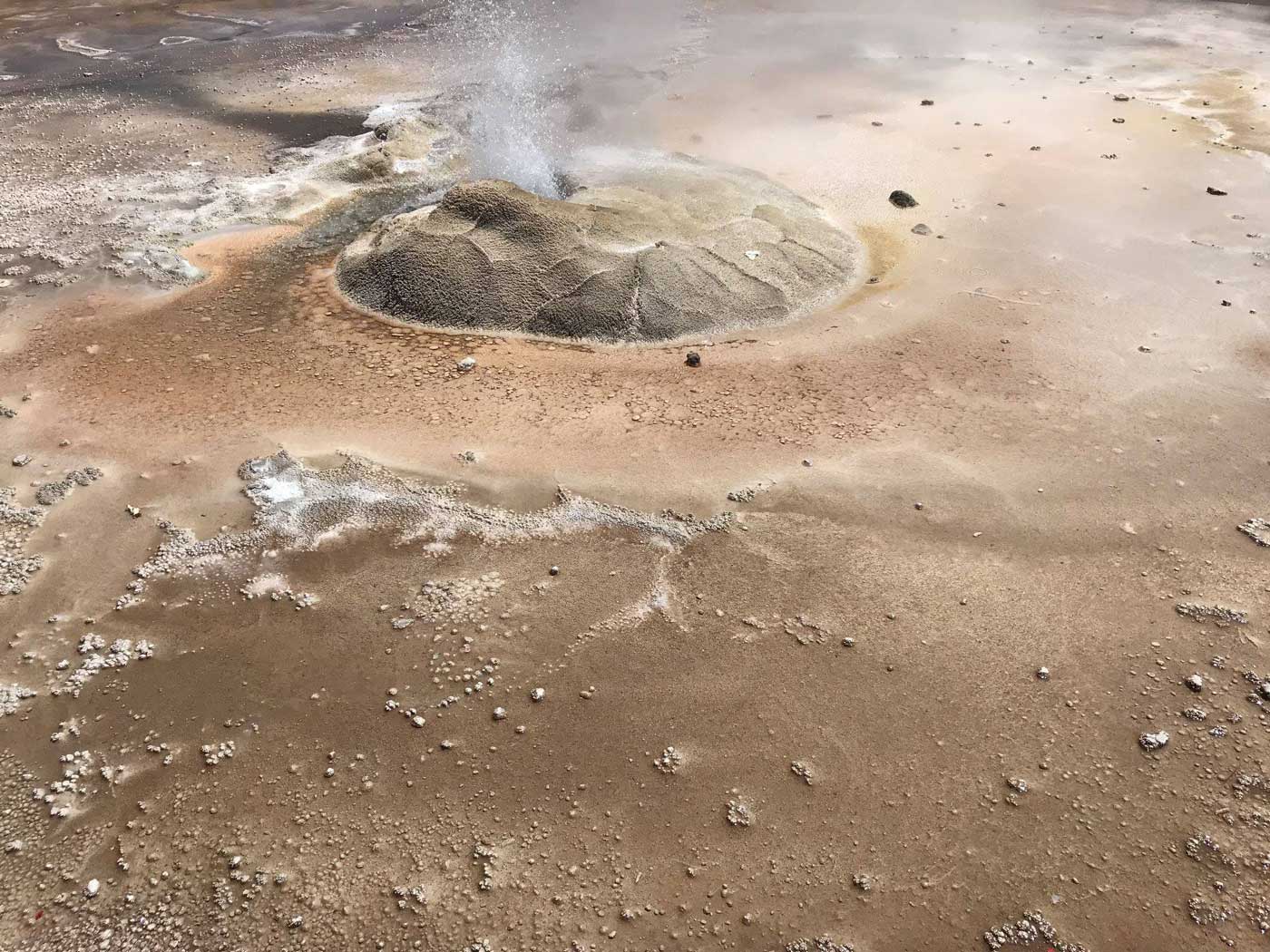
Little sinter spewing hot water. Life is everywhere... Credit photo: David Wettergreen, CMU/ The SETI Institute NAI team.
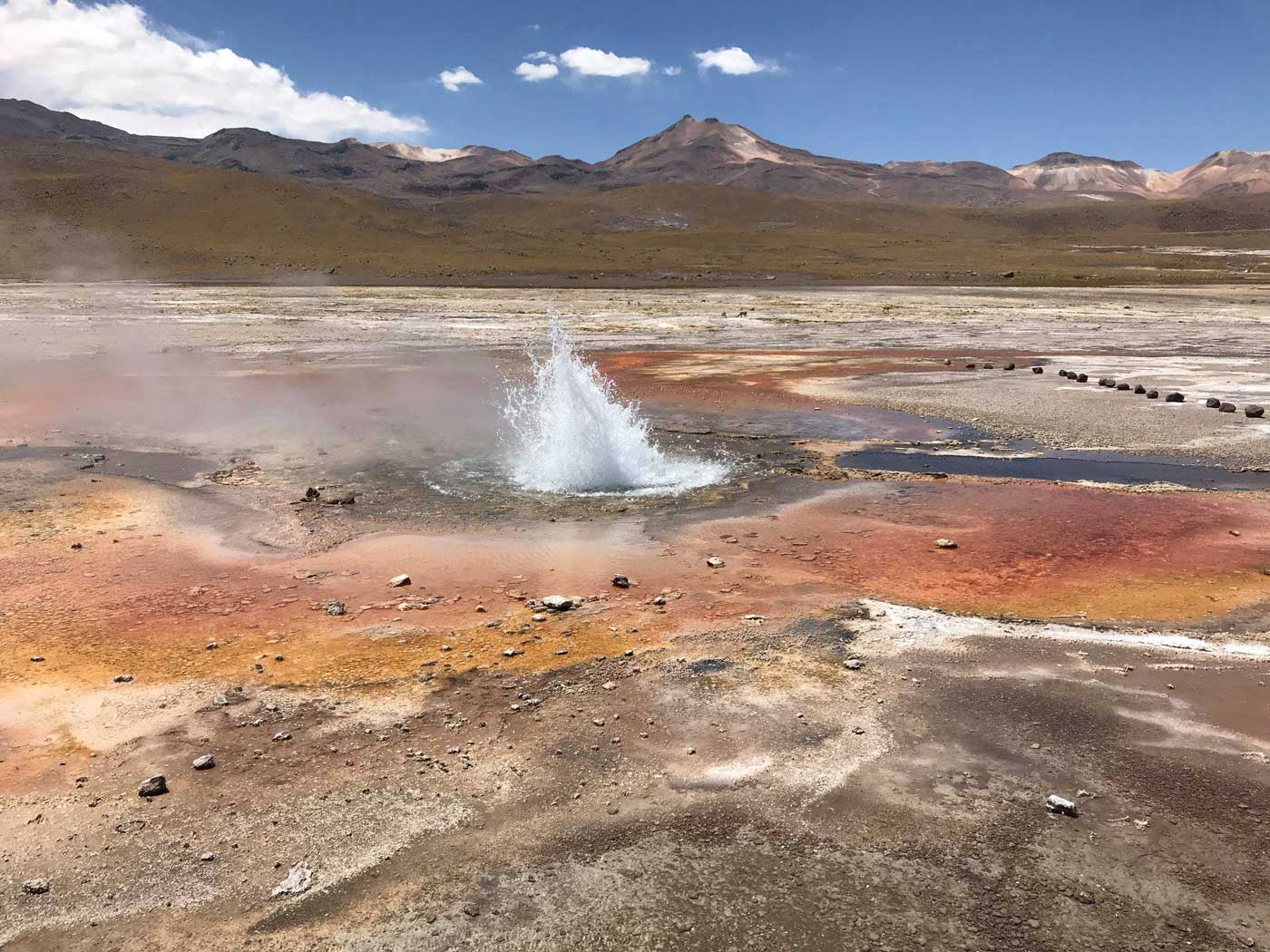
Small geyser in the main basin. Credit photo; David Wettergreen, CMU/SETI Institute NAI team.
November 8, 2018
I guess I cannot carry much more than that...Backpacks front and back, a box, and the radio...Michael took this photo yesterday morning. We have all been working very hard at Pajonales and El Tatio. Both sites have been extremely rewarding. The team is happy, and so am I. This morning at El Tatio, the UV index was close to 17 at 10AM... (11 is considered extreme). Tomorrow, the team is moving camp higher at Laguna Lejia. Me and Cristian will join them in a day. We will go back to El Tatio tomorrow to discuss with the local administration of the geyser field. They have been extremely supportive and we are grateful for their help. Tomorrow's visit will be a way to say thank you. For me, one more night in San Pedro will be welcome and hopefully will help get rid of this cold that's now going around the team. Not looking towards keeping that cold with the prospect of sleeping and working between 4,300-6,000 m (14,110-19,400 ft) in the coming week.
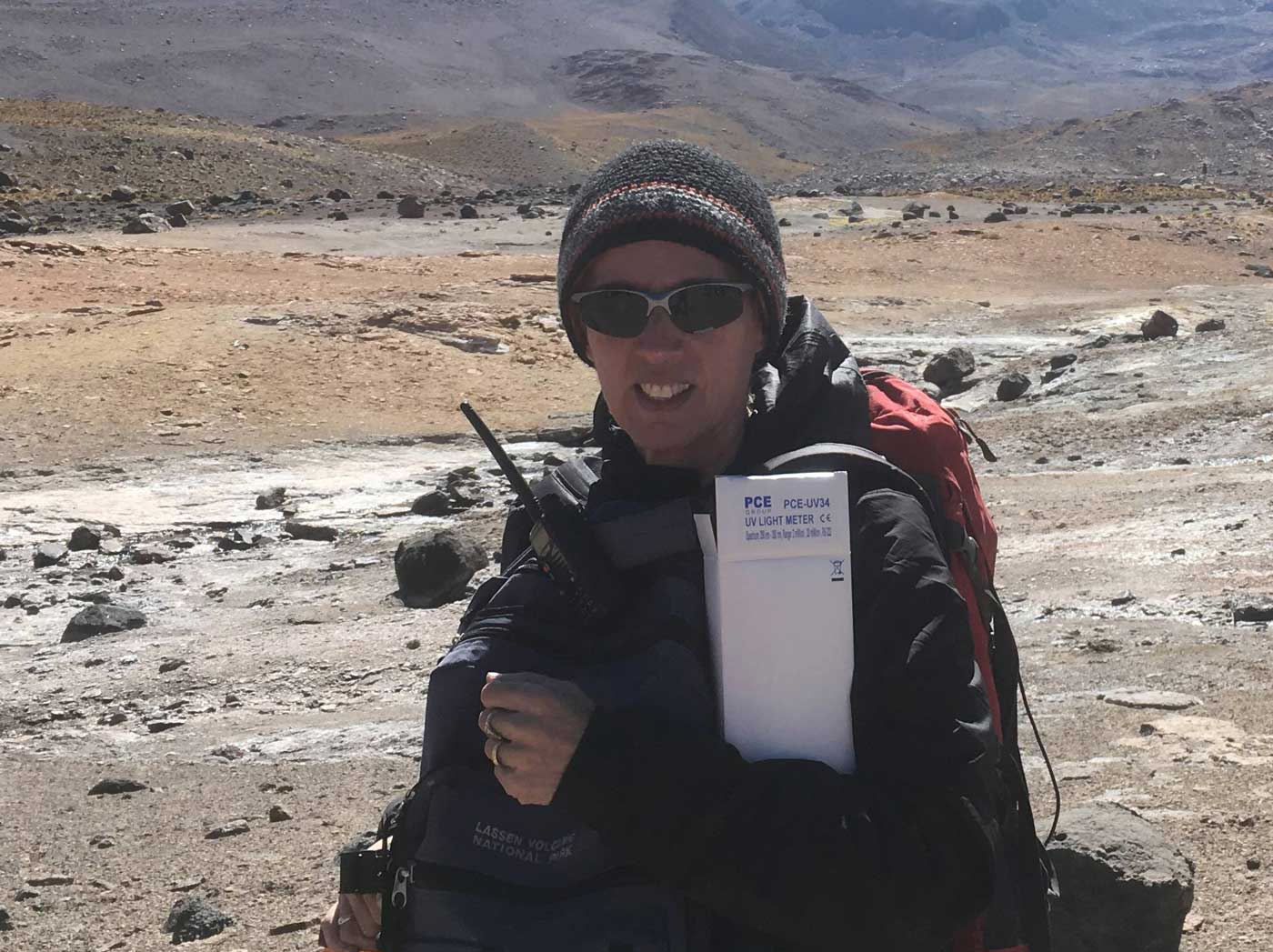
Nathalie. Credit photo: Michael Phillips, UTK and the SETI NAI team.
November 9, 2018
The last three days were spent doing fieldwork at the geyser field of El Tatio. We have accomplished a considerable amount of work, and if you believe it ends when we leave the site, think again. The team is working very hard, often late into the night (or early morning). I think I could have had a team meeting at 2AM in the salon of the hotel last night. Many of us were still up. Today, most of the team is leaving for Laguna Lejia. Me and Cristian, as well as Kim are staying behind one more day for a meeting with the management of the El Tatio site. We will be heading to the Lejia camp (4,300 m) tomorrow.
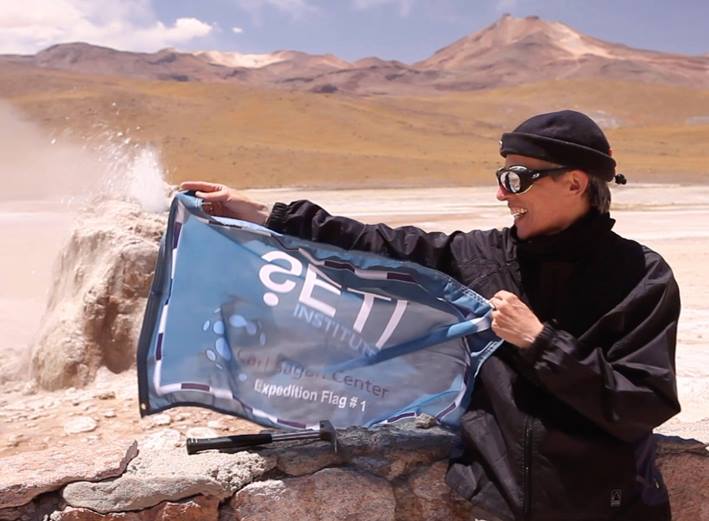
Our flag flying high and far at El Tatio, with a very friendly geyser showing off in the background. Photo credit: Victor Robles Bravo, Campoalto Operaciones, and the SETI Institute NAI Team.
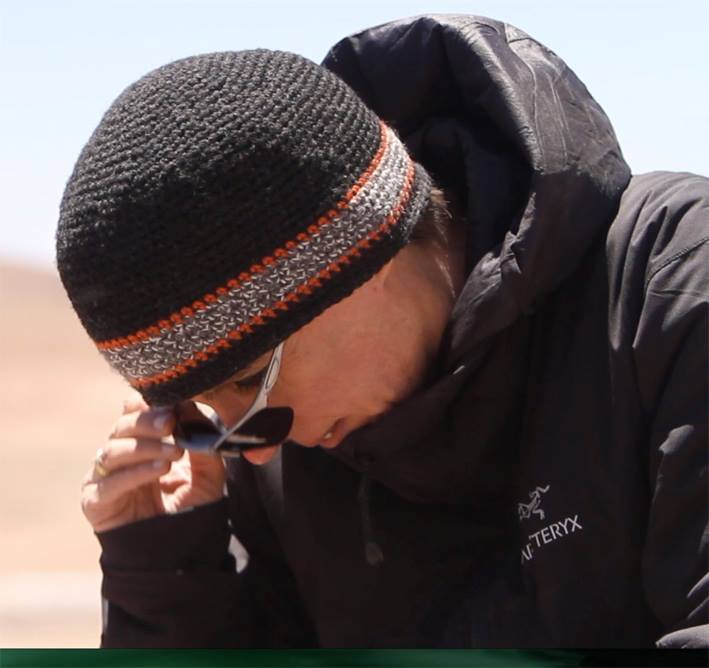
Yours truly making pH measurements in an hydrothermal spring...Better look where you put your fingers...at least until you know the result! Credit photo: Victor Robles Bravo, Campoalto Operaciones, and the SETI Institute NAI team.
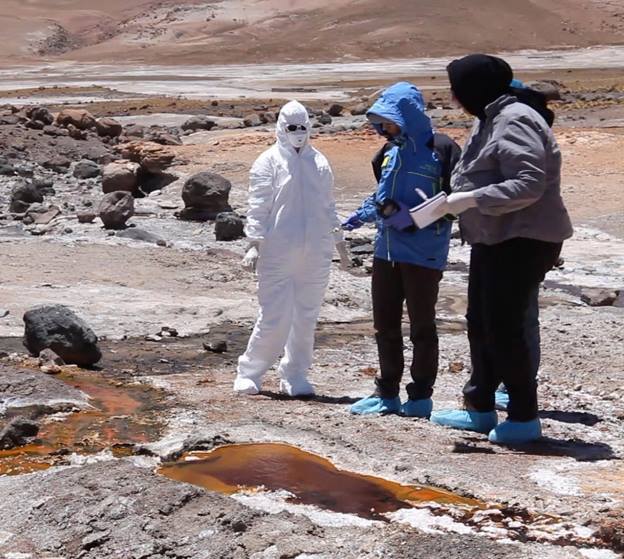
Altiplanic bunny! Kim Warren-Rhodes wears a full bunny suit to prevent contamination while collecting samples at one of the El Tatio sites. Laura and Sherry to the right. Credit photo: Victor Robles Bravo, Campoalto Operaciones, and the SETI Institute NAI team.
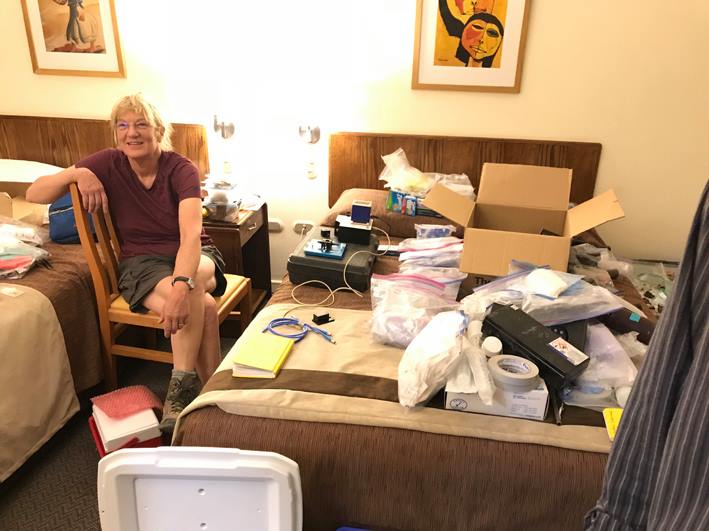
Nancy Hinman (University of Montana) also very busy making sure that everything is properly labelled and stored. Everybody is all hands on deck often times until 2 or 3AM. We are usually meeting for breakfast at 7AM, so you do the math...Credit photo: David Wettergreen, CMU Robotics Institute.
November 12, 2018
Forced Rest --- Taking a breather in San Pedro before going up again. It was unexpected...but needed, I am fine. Just 3 hard weeks of work in extreme environment dragging a cold and it is catching up with me. I want to give myself a chance to climb Simba, so, one forced night of fluffy pillow, sheets, and shower!
We are having such an amazing field campaign! This says a lot about this team because I don't know any of us who has not been hit by something, going from mild cold to more severe viruses. Poor Claudia (our doctor)...she has been on deck all the time! But, we are up and running. Yesterday was no good for me, zero energy. On the other hand, I might have pushed it just a *little* the day before digging trenches, walking miles and going up and down the lake terraces in Lejia. I can't help it. There is so much for us to see and data to collect, and not much time.
Sherry and Nancy are like two kids in a candy store. Jim and Colin found lots of rotifers in laguna Aguas Calientes too. Lots of drilling, aerial capture with drones, in situ chemistry, and for me, potentially the exposure of the Pleistocene/ Holocene transition in the ancient lake terraces. This was a bit of an emotional moment, when the book of stone (the layers) all of a sudden revealed that, on this corner of the Earth, conditions completely changed. Past varves (lake deposits associated with glacial melt) disappeared to be replaced by salt and ash deposits...which is the environment of the Holocene, arid, the one we know today. There is such an incredible poetry in geology, a sense of nostalgia of time past, but also a sense of amazement for such a dynamic planet.
It was a fantastic day but the following one was less glamorous, at least for me. That's part of the journey. Working at 4,300 m takes a toll, especially with a cold. Just need to pace ourselves, which I am doing now (me being reasonable, that would be new! I'll go back up tonight. In the meantime, I am going through some pictures that we took at El Tatio and Pajonales.
Enjoy!
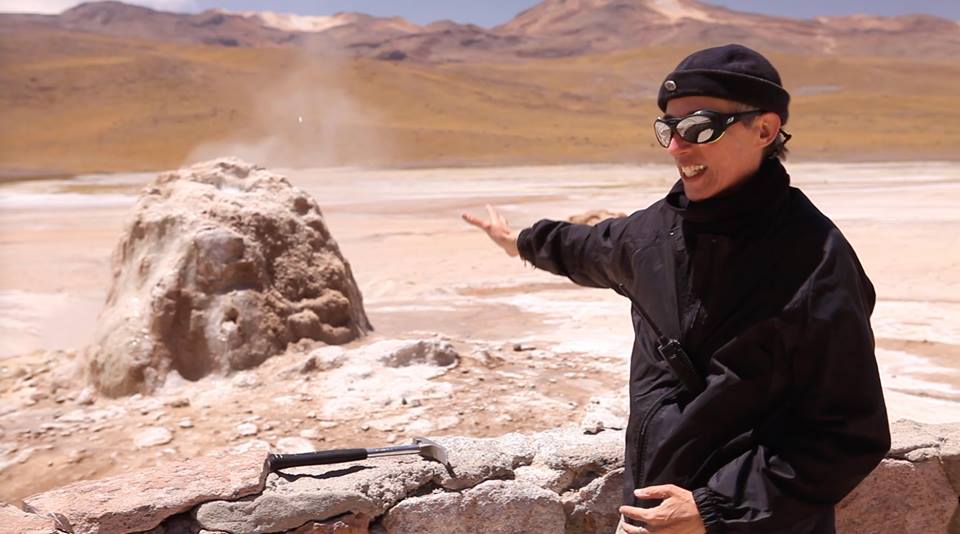
In a middle of an explanation with my favorite sinter in El Tatio. This little guy has a great sense of humor. It was making sure to punctuate our video filming with perfect timing, just to emphasize our points! Credit photo: Victor Robles, Campoalto Operaciones and the SETI Institute NAI Team.
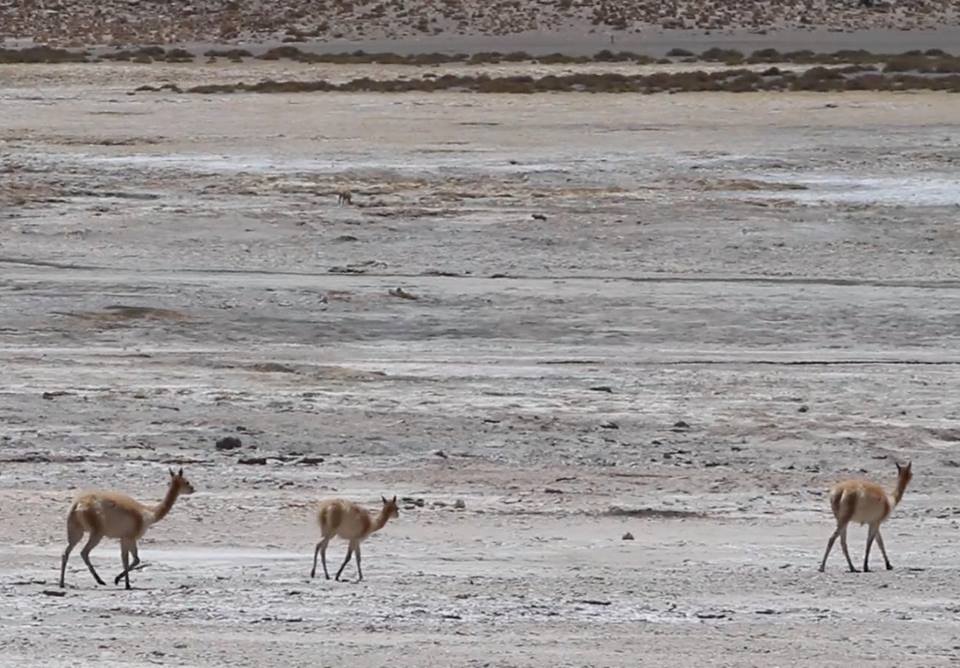
Vicuna family crossing the geyser field. "It's just another day in Paradise"...Credit photo: Victor Robles, Campoalto Operaciones and the SETI Institute NAI Team.
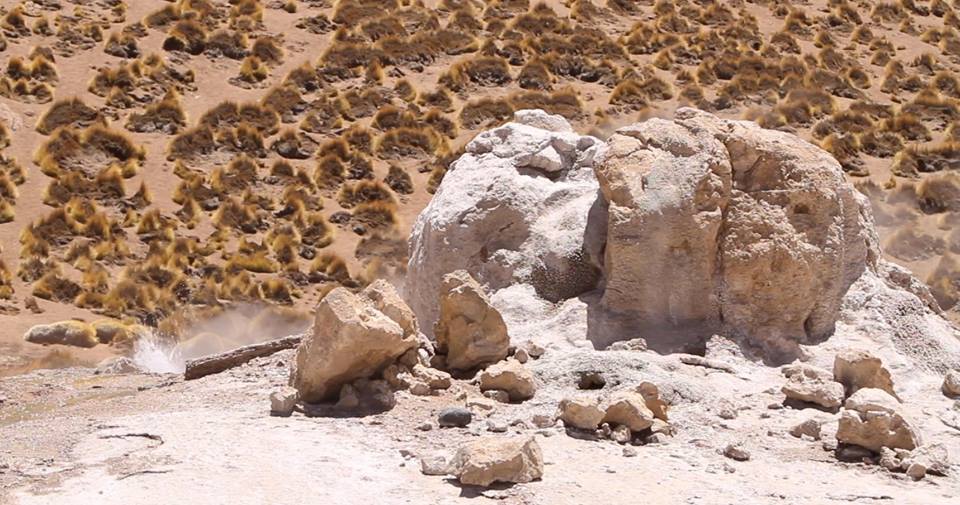
Old sinter and hot spring at El Tatio. Photo credit: Michael Phillips, UTK, and the SETI NAI Team.
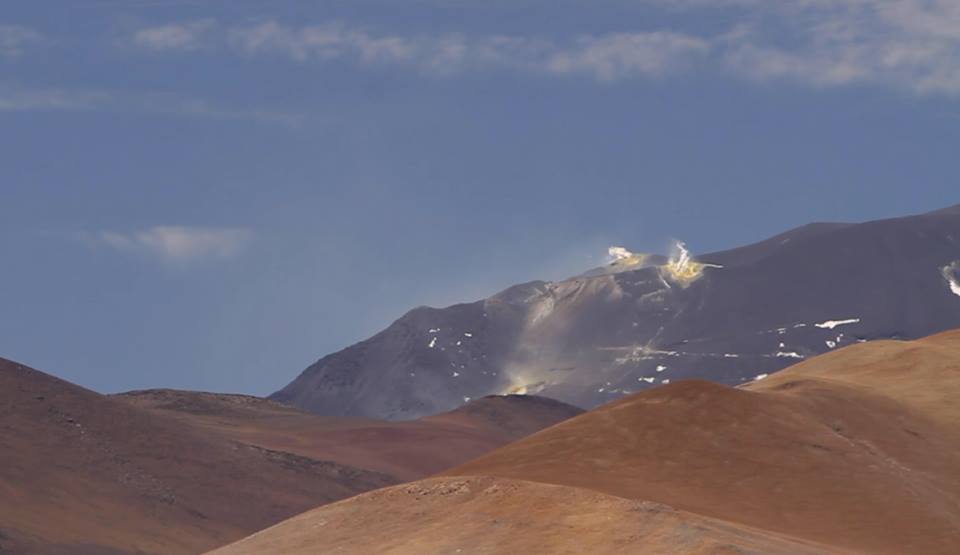
Near Salar de Pajonales, the Lastaria volcano with its daily display of fumarole activity...Credit photo: Victor Robles, Campoalto Operaciones and the SETI Institute NAI Team.
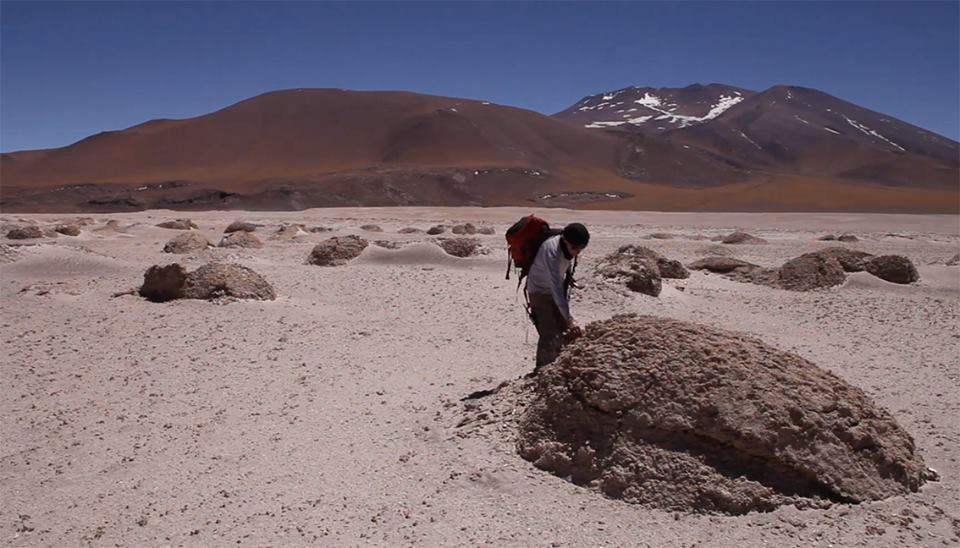
This gypsum mounds at Salar de Pajonales were incredible. While we see nothing from the surface, tiny specs of life are sheltered within those rocks. Credit photo: Victor Robles, Campoalto Operaciones and the SETI Institute NAI Team.
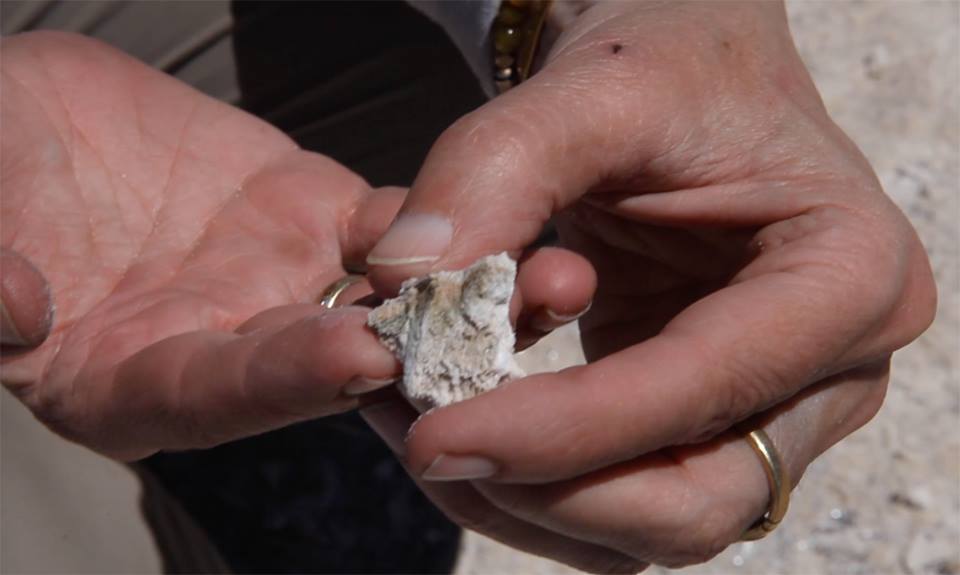
Endolithic microorganisms, hiding within a few millimeters in the gypsum crystals. Credit photo: Victor Robles, Campoalto Operaciones and the SETI Institute NAI Team.
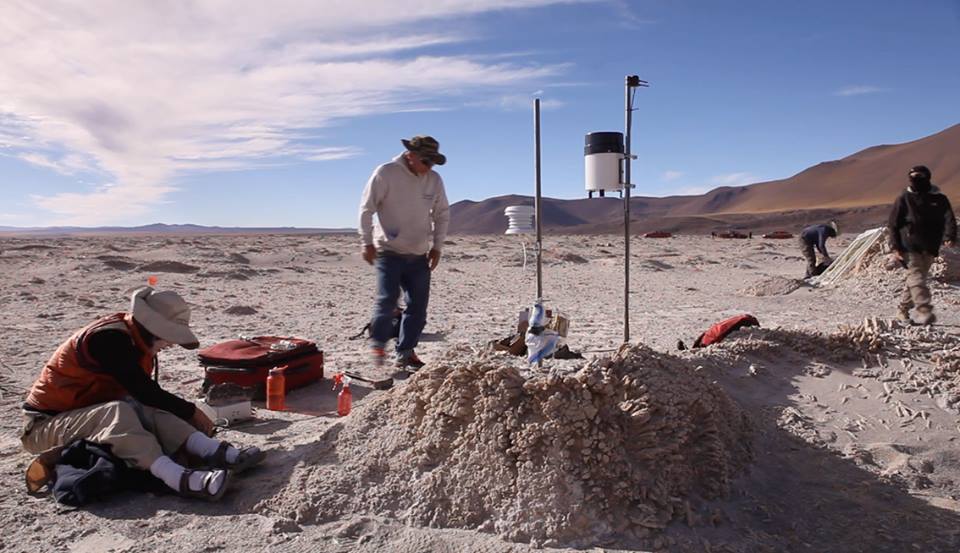
Team hard at work...Kim (left) and Kevin (middle) are setting up environmental stations on a gypsum mound in salar de Pajonales. While Nancy digs some crystals in the background, I am patrolling the field in search of the perfect place to deploy a sensor...Credit photo: Victor Robles, Campoalto Operaciones and the SETI Institute NAI Team.

The contribution of drone imagery to our field campaign and data collection is remarkable. Here, Michael surveys a transect over polygonal terrain for superresolution and 3-D mapping. We have four drones in the field: 2 large and 2 small like this one. Credit photo: Victor Robles, Campoalto Operaciones and the SETI Institute NAI Team.
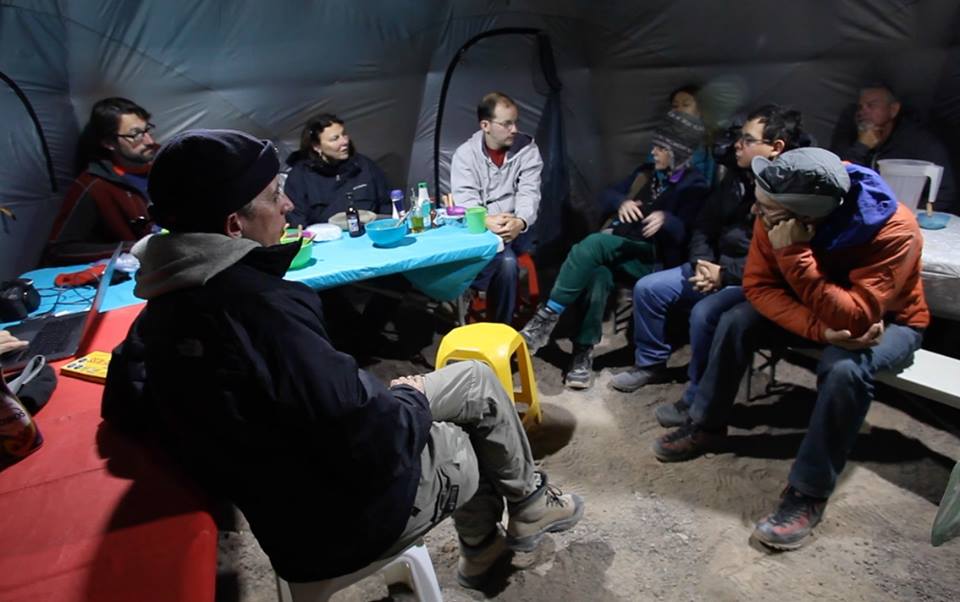
The so important team meetings and debriefings...At the beginning and end of day, the team meets to discuss the day plan and results. That helps us identify the key areas that need our attention, the scientific goals to be accomplished that day, and also importantly, understand the logistics to make them happen. Credit photo: Victor Robles, Campoalto Operaciones and the SETI Institute NAI Team.
November 12 2018 Part 2
Two updates from the field in one day, how lucky! So, here is what's going on. There is a windstorm passing through, and it is a large system. The only good news is that it is not associated with any lightning or precipitation. We just heard from Claudia that the kitchen tent almost flew away...I checked the weather forecast in the area and basically, wind gusts = wind speed, some over 55 km/hr. So, I am heading back up. The only days when it subsides a *bit* are on Wednesday and Thursday, which are those we are supposed to climb. The porters made a rotation today. They said mid-camp was windy but okay; the summit extremely windy.
Maybe another piece of good news is that the lake is thawed...which it should not, so I will bring my pH meter and take a measurement before sampling... The way it is shaping up, it looks like a "touch and go" operation: We are going in, deploying the met. station while Colin samples water and microorganisms, take some measurements with Raman, and samples, and we will be out of there. It is going to be a toughie this year...I am attaching the forecast for the day we are starting the climb. The next day will be about the same. The forecast is for Lascar since Simba does not have a station but the two volcanoes share a slope. Have a little thought for us. I think we will need it!
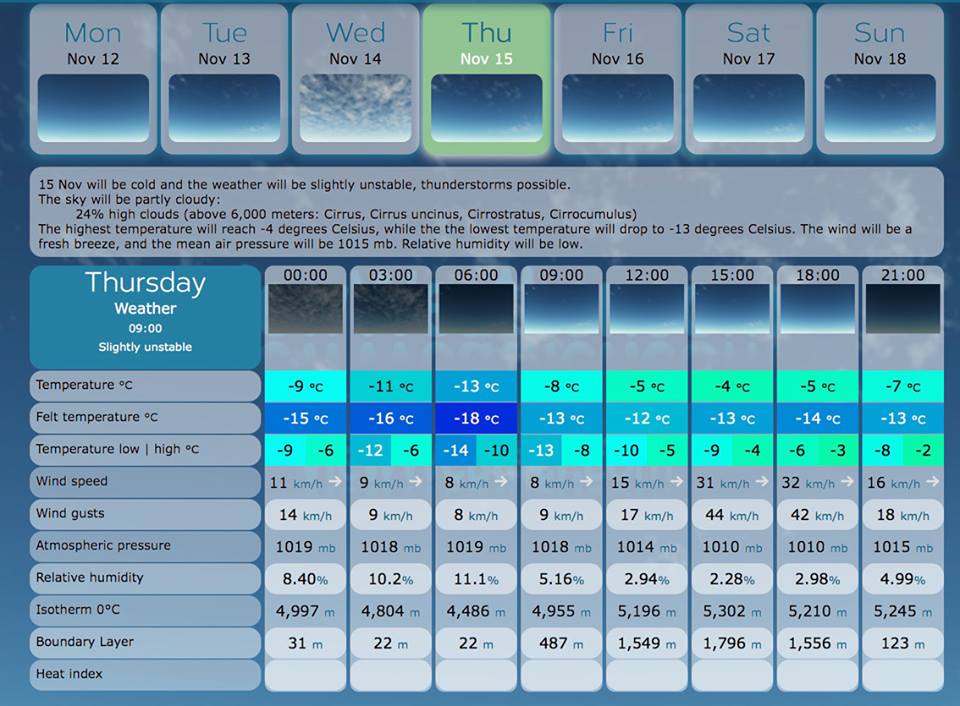
Weather Forecast
November 16, 2018
SUMMIT! I just arrived back in San Pedro de Atacama from where I am sending a brief report right now to let you know that we are all happy and healthy. The science team Colin Flinders, Pablo Sobron, Michael Phillips, Jim Larrick, and myself successfully submitted the Simba volcano between 11:40 am and 2:15pm yesterday. Circumstances dictated that I had to split the team in smaller squads. That strategy paid off. We collected all the data we came for. For now, I will just say that this ascent was the most brutal I ever had to accomplish (details to come). It was a never ending battle of mind vs. body. We made it on pure will power. I closed the descent with Jim. We descended the 1200 m face in 2 hours and 15 minutes. Right now, I am just looking to a shower, and think about an extraordinarily successful 2018 expedition. More soon. I am adding the first photos I have (from Jim Larrick and Michael Phillip) of him and me at the summit. More to come later today from the other squads. The SETI flag just logged its first summit...(19,490 ft m/5,940 m).

Jim (right), me (looking like a ninja, and two porters (Willie next to me) and Freddie. There was a third one with us, who is not in the photo. I can say without exaggerating that we could not have made it without them. They are incredible teammate and friends. They guided us up and down safely in very, very difficult conditions. Photo credit: Jim Larrick.
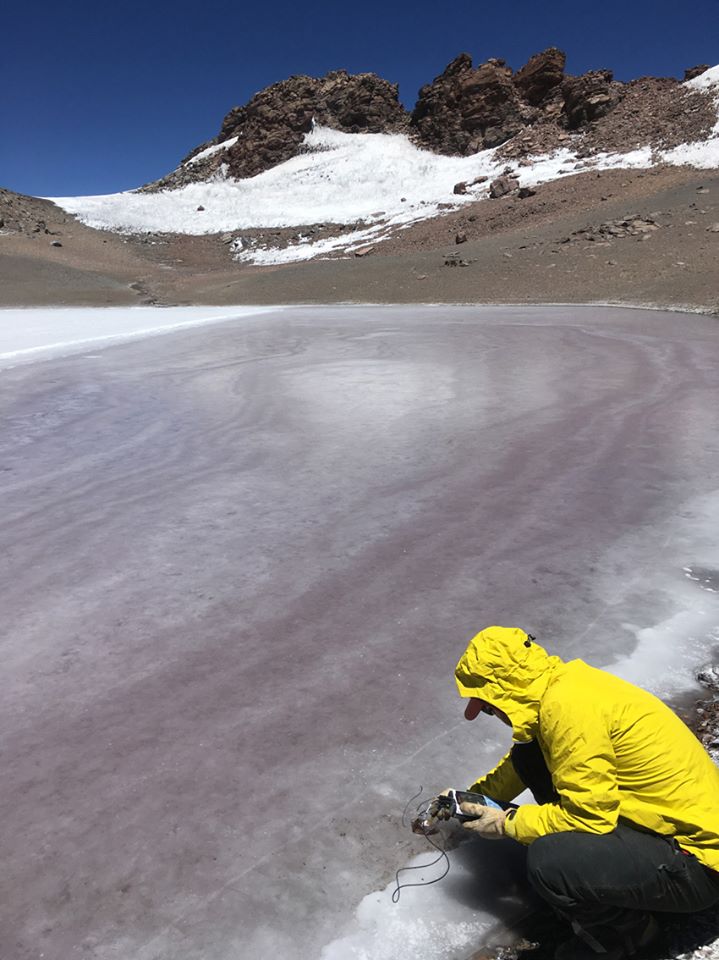
Colin Flinders measuring the pH of the lake. When we measured it first in 2007, it was 6.8. The year after, it had lower at 4.3. Colin measured it at 3.8 this year...You see the lake frozen. Two days prior the wind storm, the porters made a run to bring some equipment to the summit. The lake was completely thawed and almost purple in color. I have asked Willie who took the picture, to send it to me when he has a chance. I will post it as soon as I have it. Photo credit: Michael Phillips.
FIELD UPDATE 3
November 17, 2018
2018 SETI Institute NAI Team | The Ascent of Simba. The series of photos that will follow shows our ascent from the base, to mid-camp, to the summit. Absolutely fabulous ascent, so tough. This first set contain mostly views of the first squad. I am waiting for Jim to send me his pictures, which will show the second squad.
Thanks to Michael Phillips (UTK) for being the guardian of our memories on this ascent.
Credit for all photos not otherwise noted: Jim Larrick and Michael Phillips (UTK), and the SETI Institute NAI Team.

This is where the journey started on November 14, 2018, and where it ended a day later --- This is how far (high) the trucks could get us. We started the ascent around 4,800 m/15,750 ft at about 11AM. We reached mid camp at 3PM. In the background, the volcano Pili (Acamarachi) towers over 6,000 m/19,685 ft. We were back at the trucks the next day at 5:30PM. Credit photo: Michael Phillips (UTK), and the SETI Institute NAI Team.
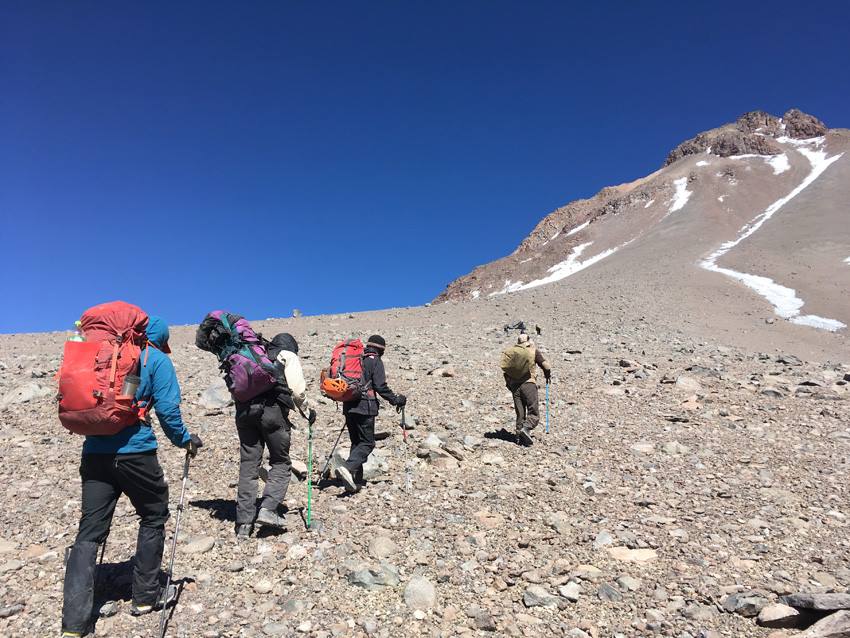
Deceivingly close | While the summit seems close, just look at the three porters in the background for scale. We had over 1,200 m (3,940 ft) to gain to reach the summit. That's the first part of the line, with Willie the chief porter and guide first, me behind him, then Jim Larrick, then Colin Flinders Credit photo: Michael Phillips (UTK), and the SETI Institute NAI Team.
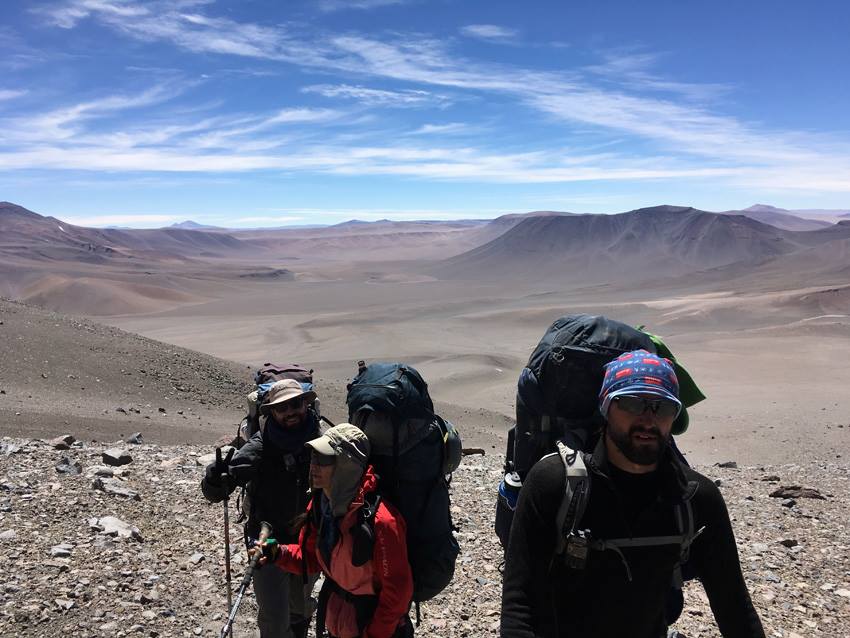
Team | Pablo Sobron, Claudia Pérez Lindemann, Cristian Tambley Aguilera. Credit photo: Michael Phillips (UTK), and the SETI Institute NAI Team.
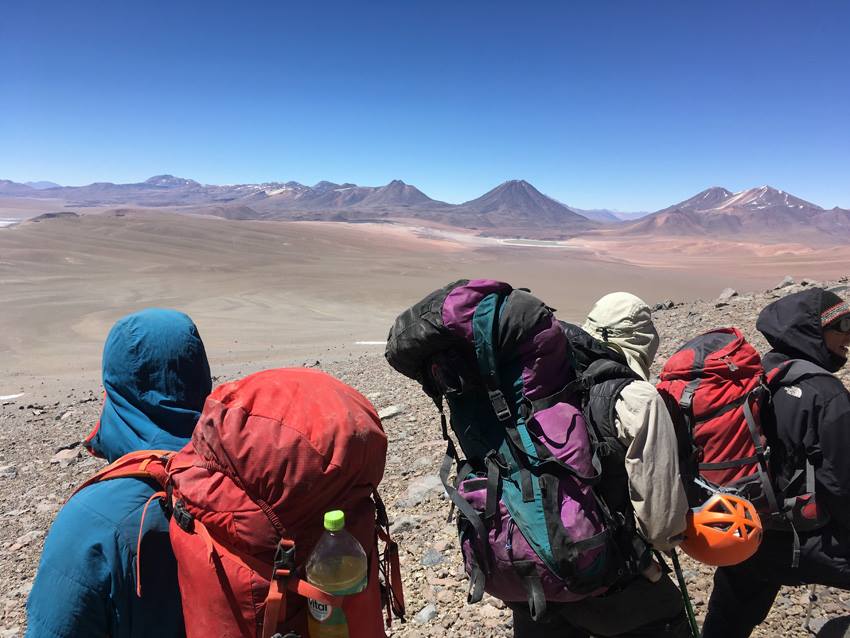
Colin Flinders who was definitely the strongest of us in this ascent summitted first the next day. What a job you did, Colin. Thanks so much! Ahead of him, Jim Larrick, and me to the right. On our way to mid-camp on November 14, 2018. Credit photo: Michael Phillips (UTK), and the SETI Institute NAI Team.
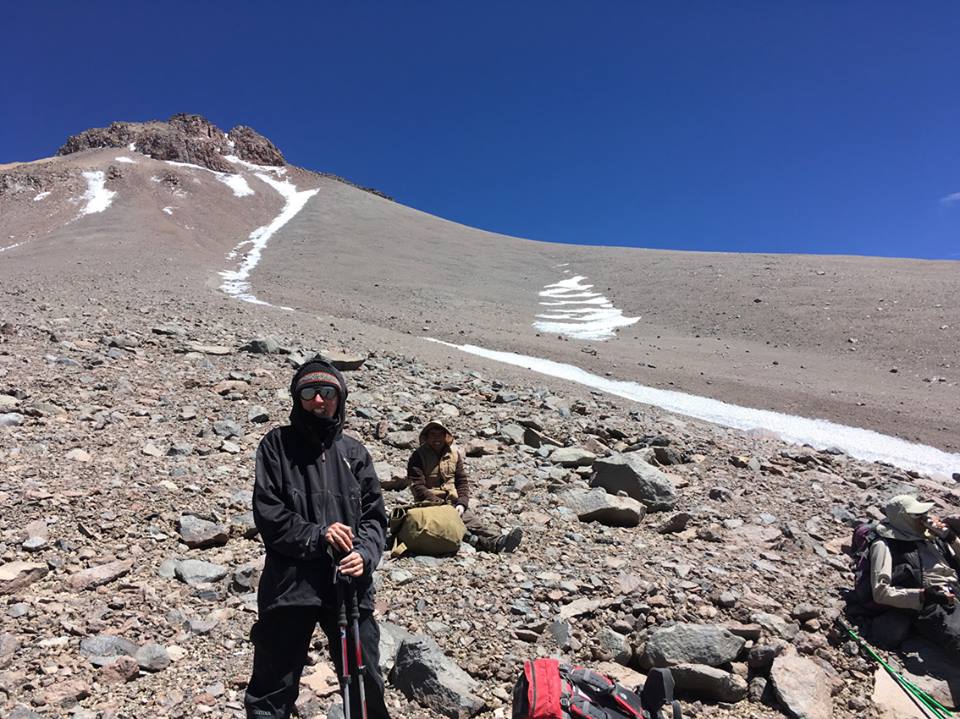
Team | This photo was taken when we were about a third of the way up to mid camp. We had no clue of what was waiting for us. Behind me, Willie has to forget that he is Bolivian and not climb the hill straight up! Credit photo: Michael Phillips (UTK), and the SETI Institute NAI Team.
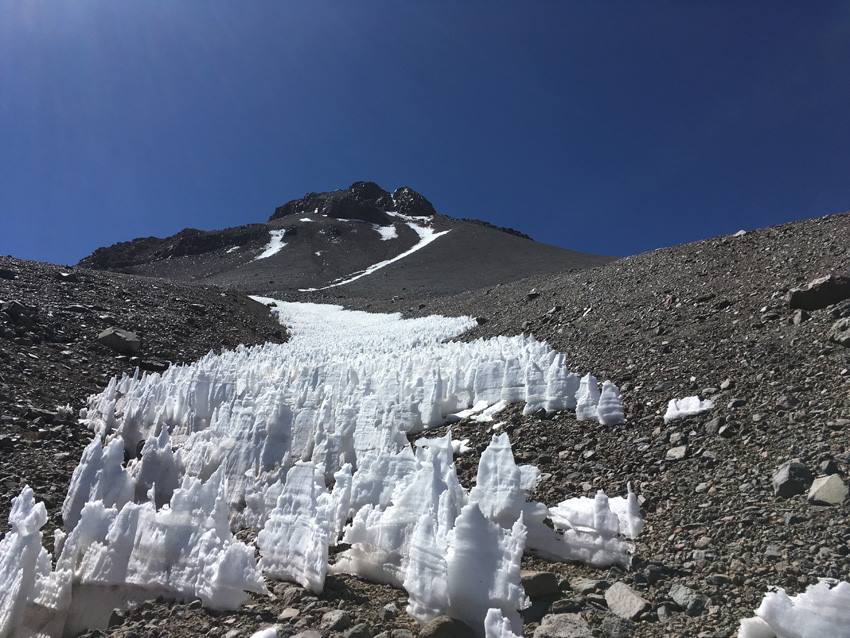
First surprise of the day...The gully that was our way up to mid-camp in 2007 and 2008 is filled with penitents which, for most, were as tall as me. We had to make a path to the left of them, and cross them very high, pretty much at the level of mid-camp (5,400 m/17,720 ft). Credit photo: Michael Phillips (UTK), and the SETI Institute NAI Team.
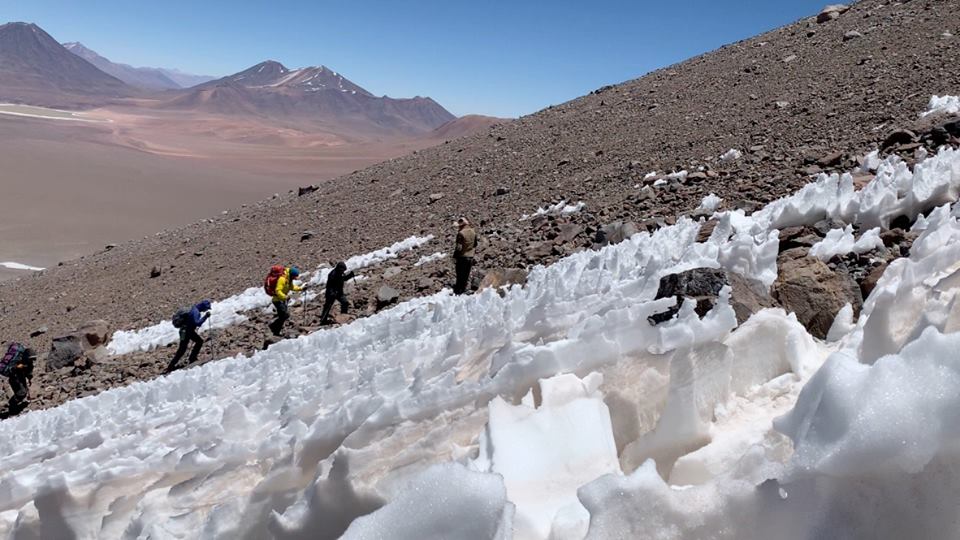
We climbed parallel to the penitents on their left for about 3 hours and half because conditions were slightly better there (a bit more rocks in the scree). We crossed them at about the elevation of mid-camp (5,400 m). From there, mid-camp was about only 30 minutes away. Credit photo: Jim Larrick and theSETI Institute NAI Team.
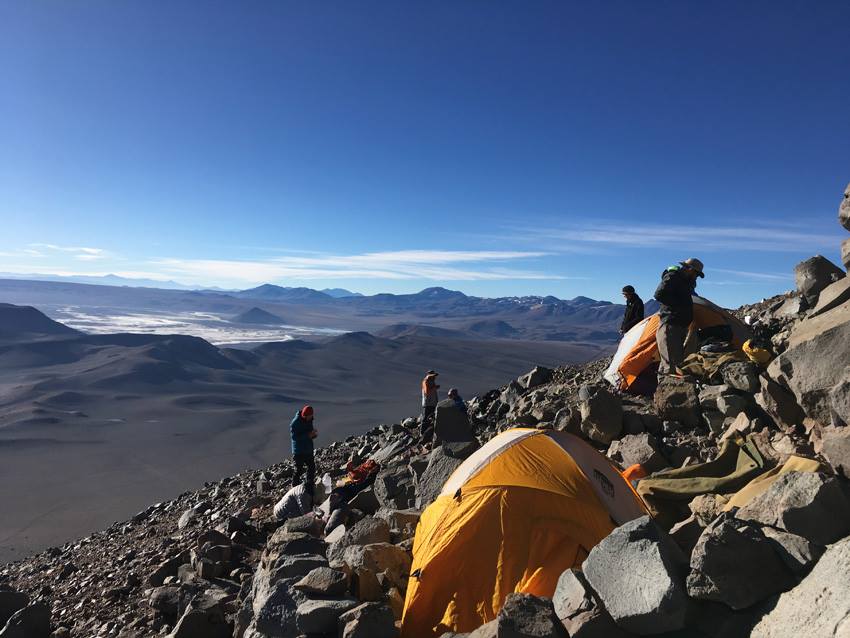
You can see some of the science team and some of the logistics team. Colin Flinders is to the left. Willie, the chief porter is next to me as I am enjoying the view from behind the tent. Right next to me, another porter, Freddie, is helping to set camp. Sleeping in thin air at 5,400 m (17,716 ft)...but the view is absolutely stunning. There, in the background, Laguna Aguas Calientes in all its glory. Credit photo: Michael Phillips (UTK), and the SETI Institute NAI Team.
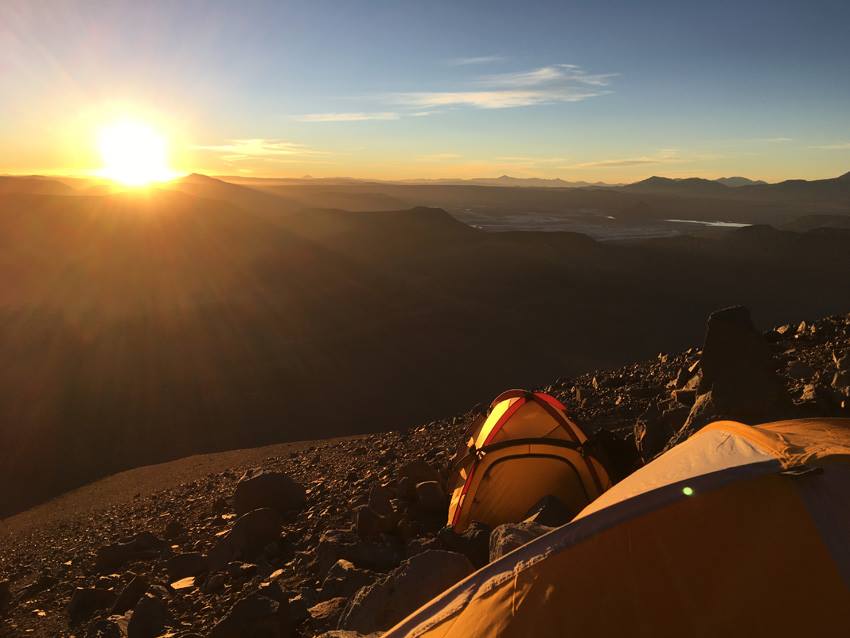
Sunrise over Argentina on November 15, 2018 | Time to get out of the tents...Credit photo: Michael Phillips (UTK), and the SETI Institute NAI Team.
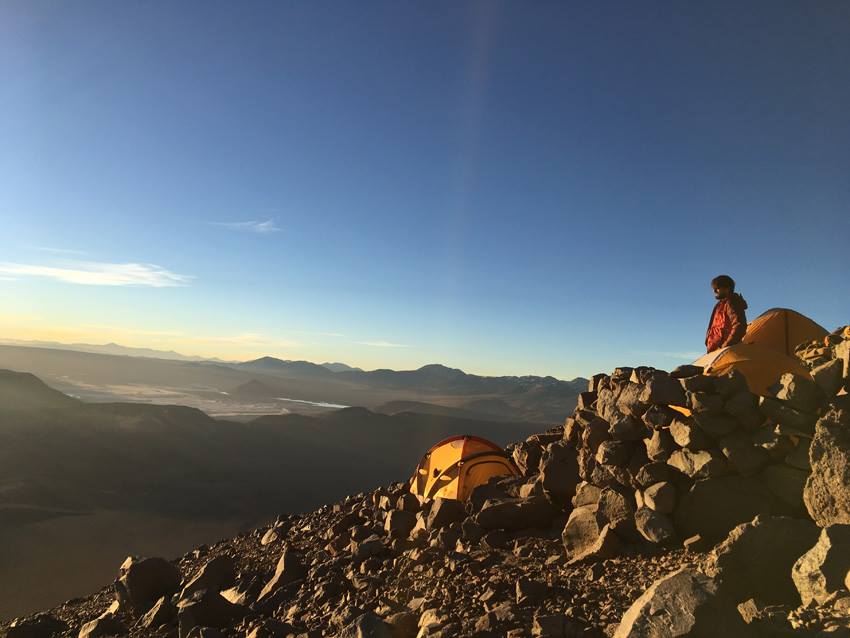
Pablo Sobron at Mid-Camp | The sun is rising over Argentina to start a day we are not ready to forget...Pablo looks into the rising sun. A few hours later, he had logged his first 5,900-m + peak. Congrats, Pablo. You did (really, really) good. Credit photo: Michael Phillips (UTK), and the SETI Institute NAI Team.
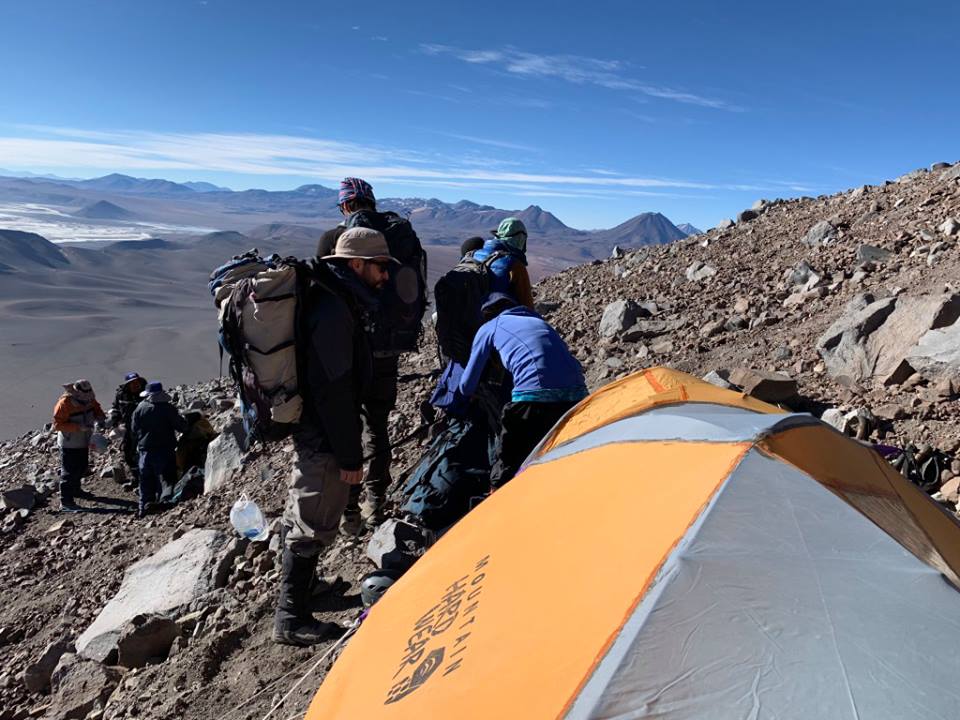
Leaving Mid-Camp | Early morning of November 15, 2018, the team prepares to leave mid-camp for the final ascent. Willie and the porters are to the left. Cristian and Claudia are chatting. Pablo and Michael look at the landscape, and I guess that's my beanie howing over Michael's left shoulder. Credit video: Jim Larrick and the SETI Institute NAI Team.
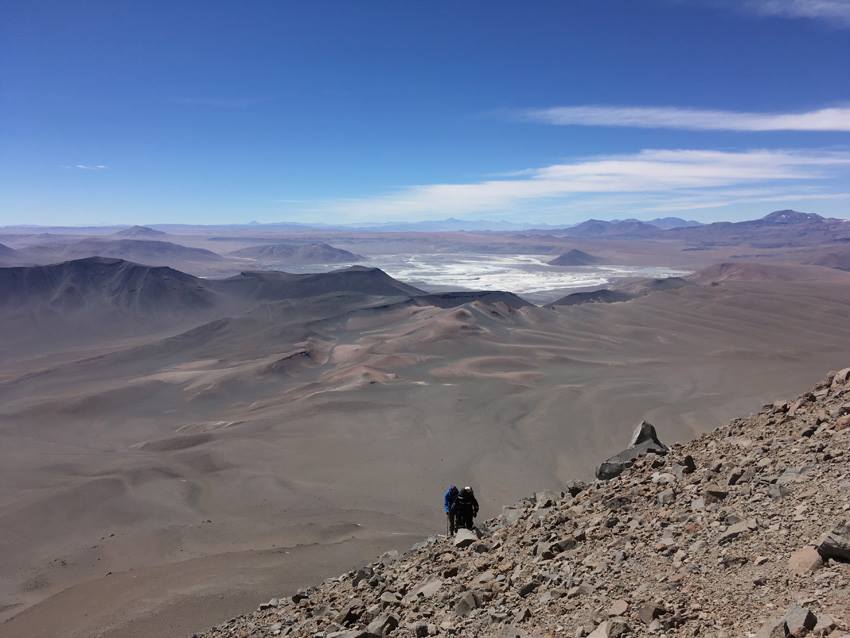
Leaving Mid-Camp 2 - November 15, 2018 | By then, I had split the team into two squads. Michael was with Pablo and Colin (seen here down below with a porter). The strategy paid off big time at the end of the day. It was windy but nothing compared to the storm we had the two previous days. On the other hand, it was cold. Credit photo: Michael Phillips (UTK), and the SETI Institute NAI Team.
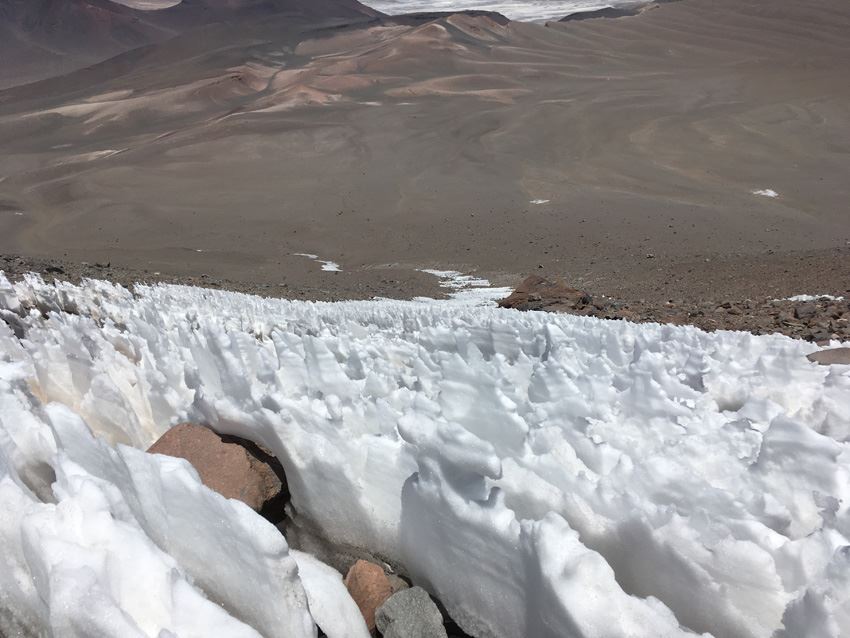
More Penitents | They completely filled the central gully of the volcano, that gully we used as an escape route in 2007 during the Tocopilla M 7.8 earthquake due to hazardous activity on the neighboring volcano Lascar...Well, not part of a plan B this time. Credit photo: Michael Phillips (UTK), and the SETI Institute NAI Team.
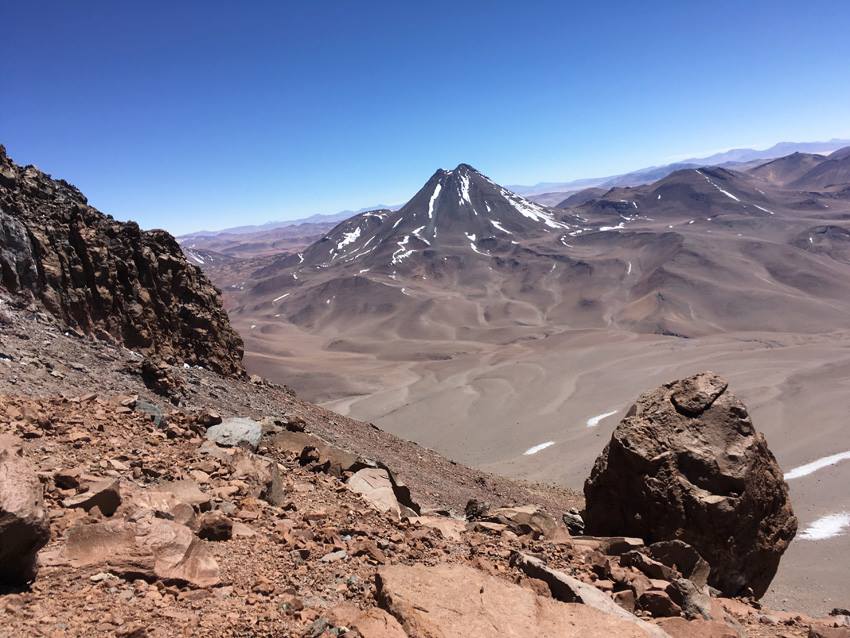
Pili and the Red Banks | One, absolutely stunning picture from Michael. Pili and its lava flows completely dominates the landscape. Meanwhile, Colin and Michael were getting close to the overhang, theoretically one hour away from the summit - emphasis on "theoretically". Credit photo: Michael Phillips (UTK), and the SETI Institute NAI Team.
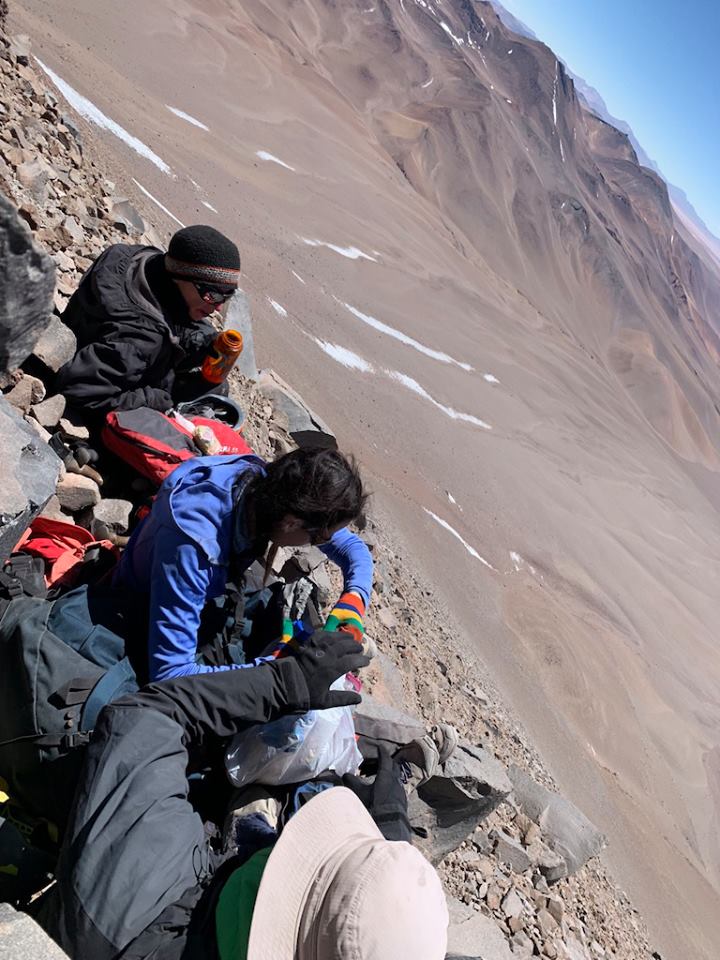
Decision Time | This is one of the last stops we made together with Claudia and Cristian. The team got hit by a number of viruses during this trip. Cristian had been spared until, unfortunately, the ascent. We tried hard, and so did he, to get him to the summit. Here, we were about one hour away. Yet, descending to mid-camp for him (and Claudia, our doctor) was the right decision to make. We parted way just a little higher in the slope, when we met the first group and when one porter became available to accompany both Claudia and Cristian. Everybody ended up fine. It is never an easy decision to make, but always the right one. Jim and I proceeded towards the summit after that. Credit photo: Jim Larrick and the SETI Institute NAI Team.
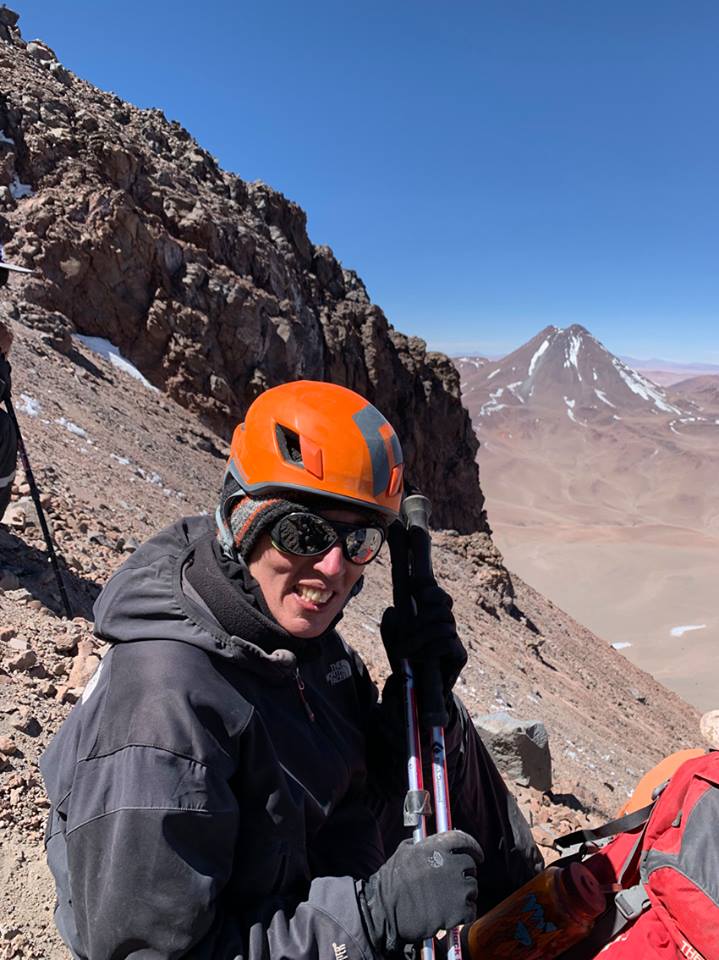
My squad finally made it to the base of the overhang after making sure that Cristian and Claudia had a porter with them to descend back to mid-camp. It was a little over 2:00PM. We needed to get fast to the summit because we did not want to be caught in the shadow of the volcano during the descent. From here, it took Jim, me, Willie and Freddie about 35 minutes to get to the summit. We had to dig dip. The helmet stayed on for the descent...1200 m descent in two hours and half...We exited the crater around 3PM and made a straight line to the trucks, finally reaching them at 5:30PM. Credit photo: Jim Larrick and the SETI Institute NAI Team.
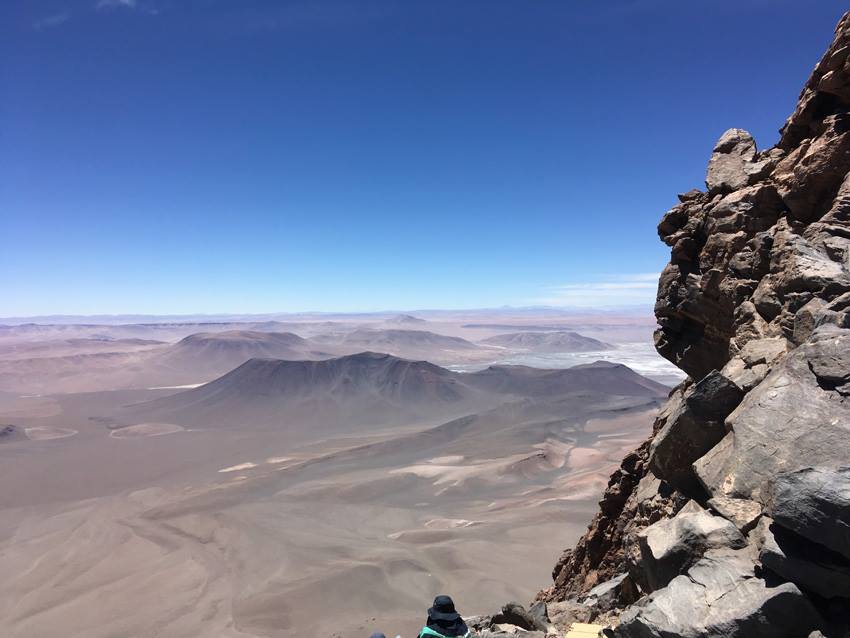
Overhang 1 | From there, the summit used to be about 30 minutes away. This year, Simba was a gift that kept on giving. Once there, we all had to face the reality that instead of easing our way up to the summit, we would have to battle against a debris field. This is what is left of the overhang I knew in 2007 and 2008. It's now mostly collapsed, leaving a debris field of huge blocks in our path. (See the next pictures). Credit photo: Michael Phillips (UTK), and the SETI Institute NAI Team.
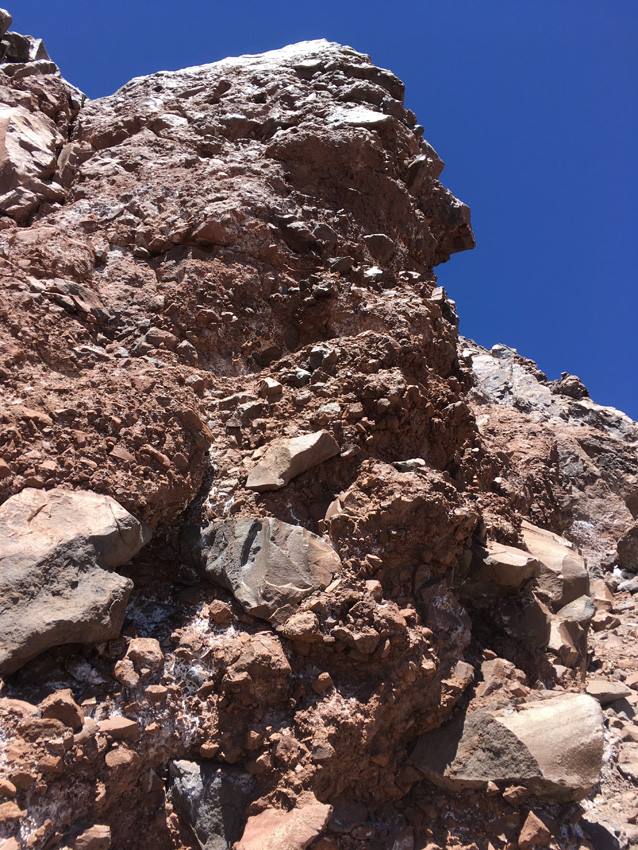
Overhang 2 | ...and voilà. The detachment face is clearly visible here, over about 30-m high. We are at about 5,850 m (19,200 ft). I seriously think that the 2016 earthquake is the culprit. We were so wise to scrub that ascent that year. I was put in a precarious situation pretty much in that same spot in 2007 because of the earthquake. Once is enough... Now, time for the brave hearts! Credit photo: Michael Phillips (UTK), and the SETI Institute NAI Team.
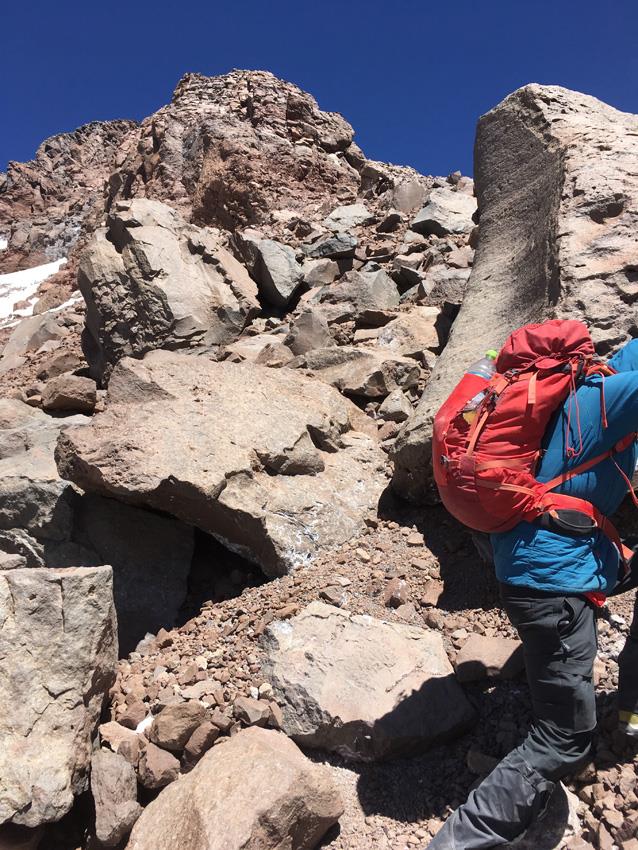
Colin was the first to summit at ~11:40AM. You see him disappear to the right. That's about 100 m of hell right there...Michael was about 20 minutes behind at the summit, and Pablo 30 minutes. Our group (Willie, Jim, and me) had been waiting for a porter so that Claudia and Cristian could descend safely back to mid-camp. We made the summit around 2PM, passing through the same blocks. Not the kind of surprise I was expecting to end the climb. Credit photo: Michael Phillips (UTK), and the SETI Institute NAI Team.
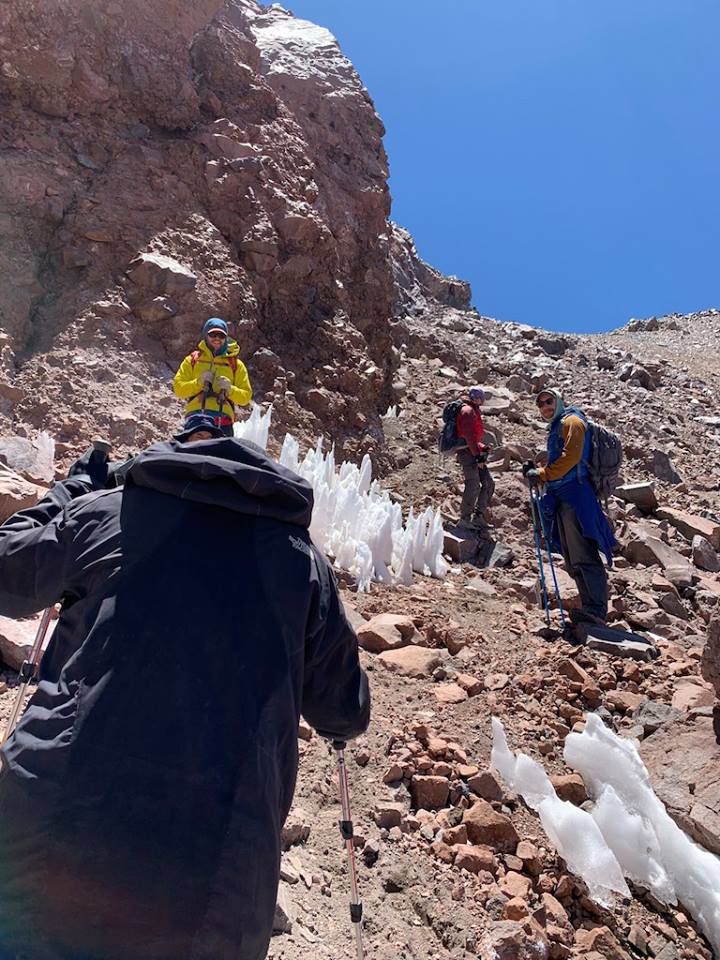
Summit Meeting | The summit is finally in view, right. up. there... After battling through the collapsed blocks, Jim and I meet Colin, Pablo, and Michael next to the overhang (what's left of it). We made it. Credit photo: Jim Larrick and theSETI Institute NAI Team.
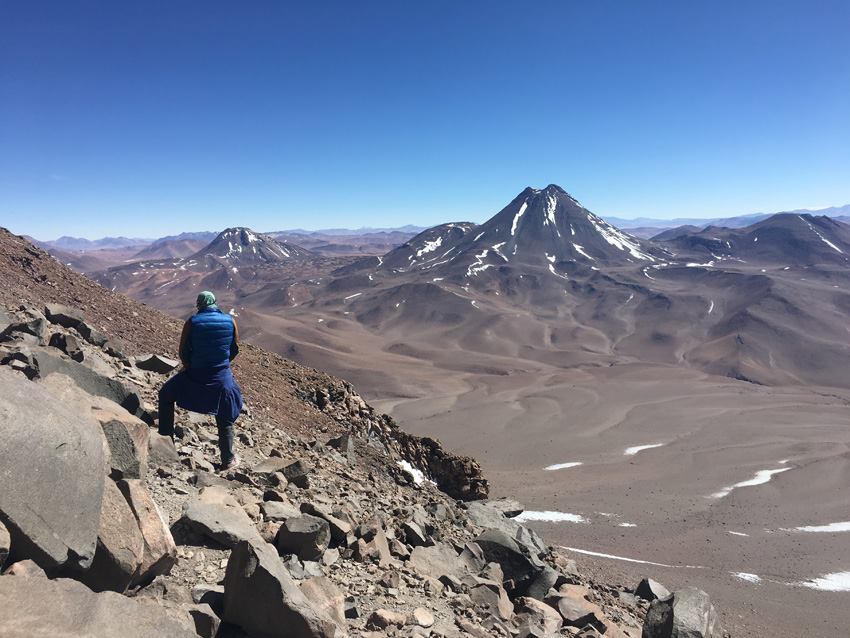
Michael near the summit | He was very close then to claiming his first 5,900-m + as well. I assume that Colin took the photo - Not sure. Beautiful! What a show of character, all of them, but you have to give it to Michael. He came to fly drones...He ended up flying higher than them!
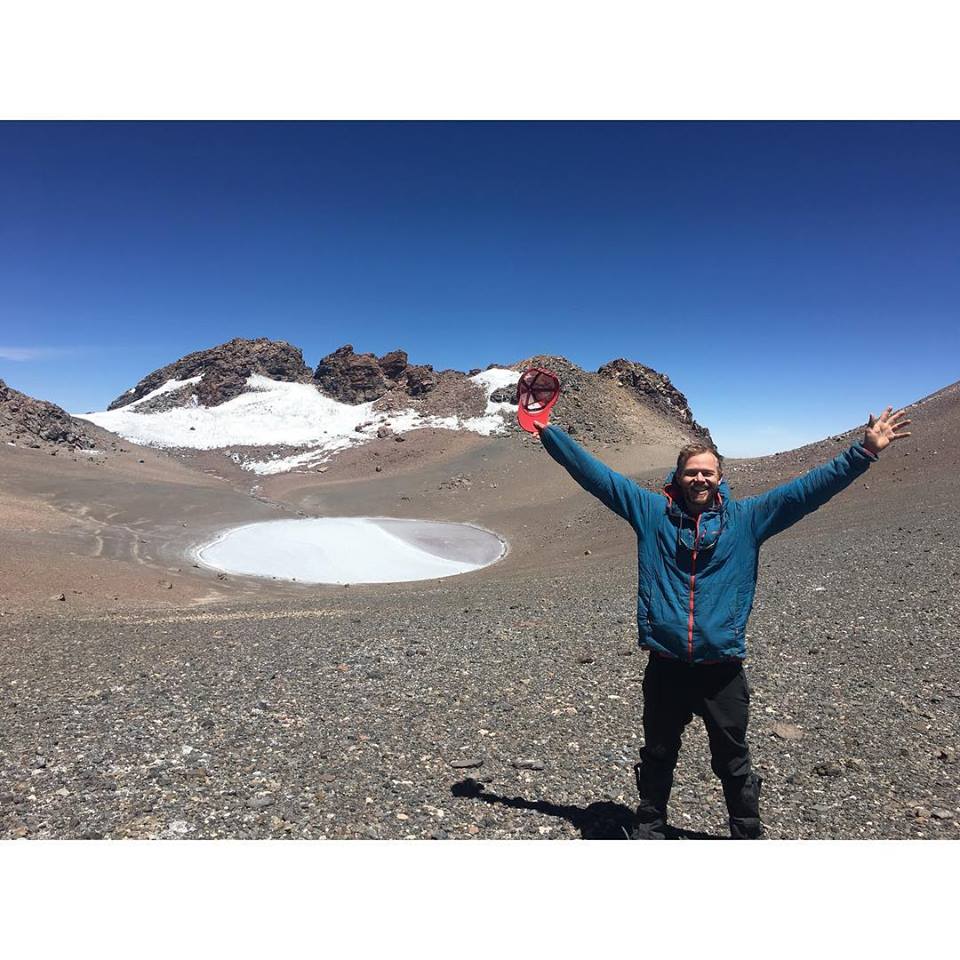
Colin at the Summit | Something to be proud of...Well done, Colin, well done! For that day, we were all on top of the world. Credit photo: Michael Phillips (UTK), and the SETI Institute NAI Team.
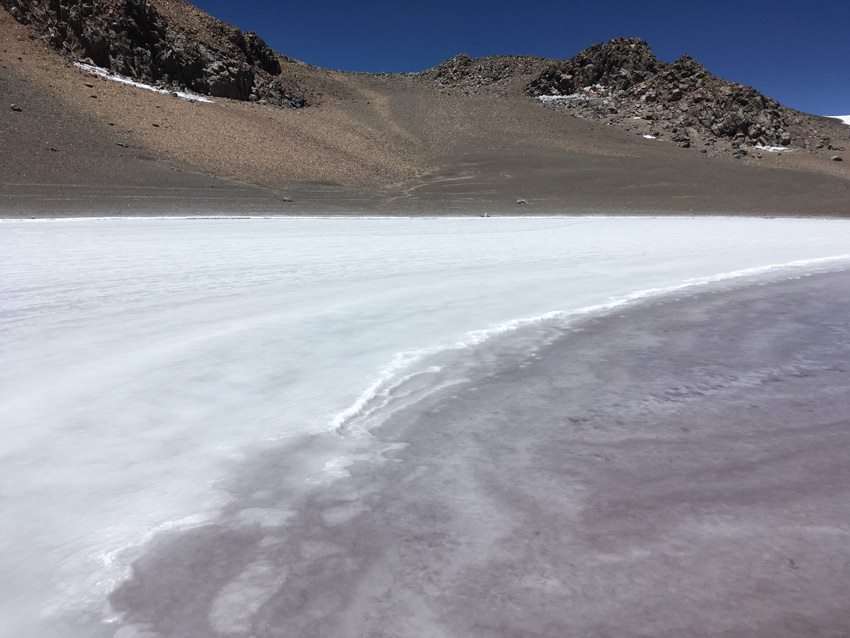
Frozen Lake | Two days before the ascent, the porters brought some equipment and took a picture of this lake, completely thawed. Then, the windstorm happened. Fortunately, the protected side had developed only a thin layer (~3 cm) that was easy to break. One very uplifting fact: The lake grew in size compared to 10 years ago. Credit photo: Michael Phillips (UTK), and the SETI Institute NAI Team.
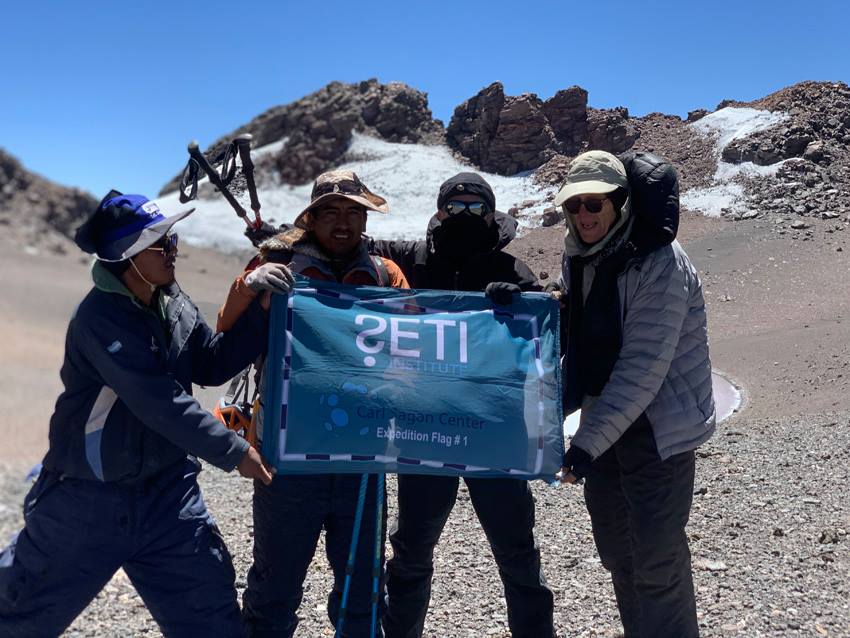
The SETI Institute flag at the summit of Simba. If I have a regret, is that we could not get the entire team at once at the summit and have a group photo. The first squad respected the cut-off time and exited the crater by 2PM. We met them halfway through the overhang. I carried the flag for the entire expedition in my backpack. With the summit of Simba, it logs its first peak at 5,940 m. In the photo, from left to right: Freddie, Willie, me, and Jim. I was very impressed with Jim. None of us were 100%. He was no exception but was simply a trooper! The SETI Institute flag is flying high and proud. One of our porters took this picture.
November 18
We are back in town! We arrived in Antofagasta from San Pedro about 45 minutes ago. As promised, Jim is now sending the pictures he took of our group while we were in the overhang. I am going to load them with the rest of the album, so please, check the album for updates in the next few minutes. Meanwhile, I am extracting this photo. I love it very much. That's our two groups, finally meeting about 50 meters away from the summit, which you can see in the background. That's this U-shaped crest. Colin (in yellow), Pablo (in red), and Michael (in blue) are starting the descent. We are ready to summit. Willie is keeping a watchful eye on everybody. Our strategy worked perfectly. Despite weather, delays, and brutal climbing conditions, the primary science was successfully achieved. Way to go team! Photo Credit: Jim Larrick and the SETI Institute NAI Team.
Videos
Touching the Sky | Finally there... Jim captured our arrival at the summit and the (quite literally) breathtaking panorama of the crater and its lake. That was one incredible day...After that, we still had ~ 4000 ft (1200 m) to descend before it got too dark and cold. Credit video: Jim Larrick and the SETI Institute NAI Team.
A Seat with a View | Okay, the next two videos have a special place in my heart because of what it took us to get there! This was our last stop at the foot of the overhang before summitting. I am chatting with the porters and Jim is shooting this incredible video. Look at where we are!!! Any higher and I would have to grow feathers! It also gives you a better idea of how steep this last stretch was. Credit video: Jim Larrick and the SETI Institute NAI Team.
Here is a first short video captured by Jim Larrick as we are getting ready to cross the field of penitents and finish the last stretch (about 30 minutes) to mid-camp on November 14, 2018. Credit video: Jim Larrick and the SETI Institute NAI Team.
The Crossing | This was spectacular. Some go the penitents were about as tall as me, and a nice little runoff of ice melt could be seen and heard just at their base. You can hear the wind as well. Nothing came easy on this volcano this year but the reward is even greater. Credit video: Jim Larrick and the SETI Institute NAI Team.
Building Mid-Camp | Credit video: Jim Larrick and the SETI Institute NAI Team.
//-->





